

Mastering the Art of Sailboat Docking: A Step-by-Step Guide
Alex Morgan
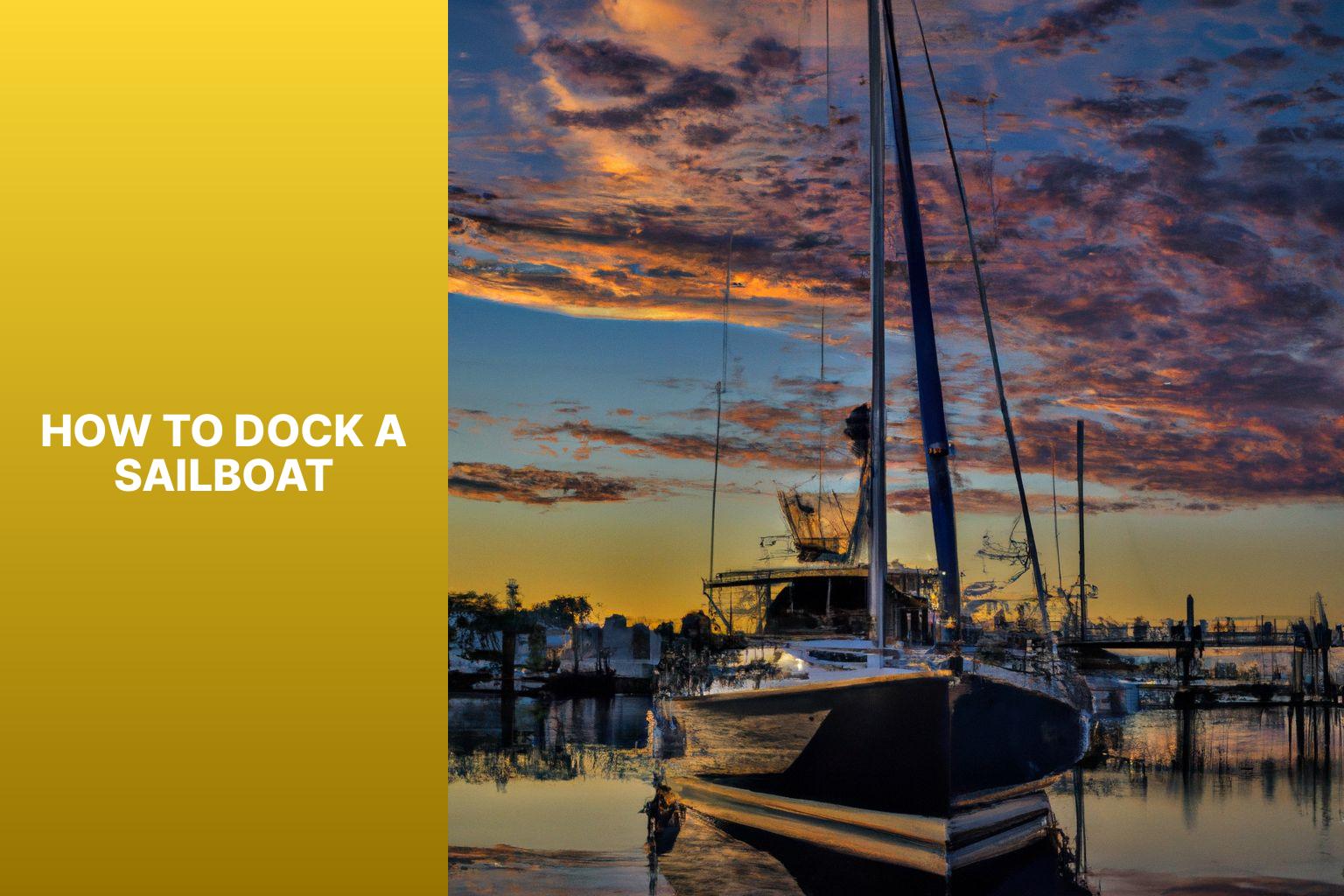
Docking a sailboat can seem like a daunting task for beginners, but with the right techniques and preparation, it can be easily mastered. Proper docking is essential for the safety of the boat and its passengers, as well as the surrounding docks and vessels. Understanding the fundamentals of sailboat docking and following certain steps can ensure a smooth and successful maneuver.
Approaching the dock at the correct angle is the first step in a successful docking. This involves considering the wind direction and the desired position of the boat relative to the dock. Proper communication and signals between the crew members are crucial during the docking process to ensure coordination and smooth execution.
Before starting the docking maneuver, it is important to make necessary preparations. This includes reducing the sail area to control the speed of the boat, securing loose items on deck to prevent them from falling overboard, and assigning roles and responsibilities to each crew member.
During the actual docking maneuver, a slow approach with controlled speed is recommended. Utilizing spring lines can aid in positioning the boat alongside the dock, while utilizing fenders can protect the boat and the dock from any potential damage. Understanding how wind and current affect the boat can also be advantageous during docking.
While docking challenges can sometimes arise, such as dealing with strong winds or limited space for maneuvering, having a troubleshooting plan in place can help overcome these obstacles effectively.
It is important to remember that practice makes perfect when it comes to sailboat docking. Regular practice in different docking scenarios can help build confidence and improve skills, ensuring a smoother docking experience in the future.
By understanding the fundamentals, preparing properly, executing the docking maneuver with precision, troubleshooting challenges, and practicing regularly, anyone can successfully dock a sailboat and enjoy the thrill of sailing with confidence.
Key takeaway:
- Proper approach angle: When docking a sailboat, it’s important to approach the dock at the correct angle to ensure a smooth and safe maneuver.
- Effective communication: Communication and signals play a crucial role in successful sailboat docking. Clear communication between the crew and the person at the helm is essential.
- Preparation is key: Before docking, it is important to reduce sail area, secure loose items, and assign roles and responsibilities to ensure a coordinated and organized docking process.
Understanding Sailboat Docking Techniques
When it comes to docking a sailboat, understanding the proper techniques is key . In this section, we’ll dive into two crucial aspects: approaching the dock at the correct angle and utilizing effective communication and signals. By mastering these essential skills, you’ll be equipped to navigate the docking process smoothly and with confidence. So, let’s explore the art of sailboat docking and unlock the secrets to a successful and stress-free experience on the water.
Approach the Dock at the Correct Angle
Approaching the dock at the correct angle is crucial for successful sailboat docking. To ensure proper approach, it is important to assess wind and current direction. By determining the ideal approach angle, usually around 30-45 degrees , maneuvering and boat control become easier. It is essential to adjust the angle according to the wind direction, aiming to approach into the wind. This approach reduces drift and enhances safety. To improve maneuverability, it is advisable to maintain a slow and controlled speed. Effective communication with the crew or dockhands is vital. This ensures everyone is aware and prepared for the docking process.
Use Proper Communication and Signals
Proper communication and signals are essential when docking a sailboat. Clear and concise hand signals play a vital role in ensuring effective communication between the helmsperson and crew members. These signals can include pointing the direction to steer or indicating when to start or stop the engine, enhancing coordination during the docking process.
Using a VHF radio is another useful method of communication. It allows sailors to communicate with dock personnel or other nearby boats. This is especially helpful in larger marinas or crowded docking areas. Clear and concise radio communication ensures that everyone is aware of your intentions and can provide assistance if needed.
Assigning roles and responsibilities to each crew member before starting the docking maneuver is crucial. This includes tasks such as handling lines, operating fenders, and communicating with dock personnel. Clear assignments ensure that everyone knows their tasks and can act accordingly.
Maintaining eye contact between the helmsperson and crew members is important during the docking process. It allows for non-verbal communication and helps convey important information or directions.
In situations where direct communication is not possible, a whistle or horn can be used to communicate signals. For example, a short blast could indicate a change in direction, while a long blast could signal an emergency situation.
Remember, clear and effective communication , along with proper signals, significantly contribute to a successful sailboat docking. Practice these techniques with your crew to ensure smooth and safe docking experiences.
Practice and experience are key to mastering the art of docking a sailboat. So keep practicing and refining your skills to become a proficient sailor.
Preparing for Docking
Preparing for docking is a crucial aspect of successfully maneuvering a sailboat. As we delve into this section, we’ll discover the key steps involved in ensuring a smooth docking process. From reducing sail area to securing loose items and assigning roles and responsibilities , we’ll explore the essential preparations that will help you navigate the docking procedure with ease. So, get ready to take charge and handle your sailboat like a pro as we uncover the secrets to a seamless docking experience.
Reduce Sail Area
Reducing sail area is crucial for a successful docking maneuver on a sailboat. When approaching the dock, it is essential to assess the wind conditions by determining the wind direction and strength. Depending on the intensity of the wind, it is necessary to ease the mainsail halyard and lower the mainsail partially or completely to reduce its size. If the wind is still strong, it is advisable to consider furling or reefing the headsail to further decrease its size and minimize the sail area. In situations where reefing the headsail is not sufficient, switching to a smaller headsail or jib that is better suited for the wind conditions becomes necessary. To ensure a smooth docking, it is crucial to secure all the lines and sheets, preventing tangling or unnecessary drag. By reducing the sail area, the force generated by the wind decreases, facilitating better control and maneuverability of the boat into the dock.
Secure Loose Items
When docking a sailboat, it is crucial to secure loose items for a safe and successful maneuver. Follow these steps:
– Remove items from the deck or cockpit that could become projectiles during docking, such as loose equipment, bags, or personal belongings.
– Stow loose lines and halyards to prevent tangling or catching on the boat or dock.
– Secure loose sails by furling or tying them down to prevent unfurling or damage from wind or other elements, including mainsails, jibs, and other in-use sails.
– Properly store loose equipment or tools in lockers or compartments to avoid accidents or damage during docking.
By securing loose items before docking, you can reduce the risk of accidents, protect your belongings, and ensure a smooth and efficient process.
Fact: Securing loose items not only contributes to a safe docking procedure but also helps maintain the cleanliness and organization of the sailboat.
Assign Roles and Responsibilities
Assigning roles and responsibilities is crucial for smooth and safe sailboat docking. Here are the steps to follow:
- The captain steers the boat and gives instructions.
- The crew member handling lines stands ready at the bow or stern, depending on the docking situation.
- Another crew member handles the fenders to protect the boat in the correct position.
- Additional crew members can help secure lines or guide the captain.
By assigning roles and responsibilities, everyone knows their tasks and can work effectively together. This prevents confusion and ensures proper management of each aspect of the docking maneuver. Communication between the captain and crew members is essential so everyone is aware of their assigned roles. Practice and coordination among the team lead to successful docking experiences.
Executing the Docking Maneuver
When it comes to docking a sailboat, mastering the art of executing the docking maneuver is crucial . In this section, we’ll uncover the secrets behind a successful docking by exploring sub-sections such as the slow approach and controlled speed , utilizing spring lines , making the most of fenders for protection, and harnessing the power of wind and current to your advantage. So, get ready to enhance your docking skills and navigate any harbor with confidence!
Slow Approach and Controlled Speed
When approaching a dock with a sailboat, it is crucial to maintain a slow approach and controlled speed for a safe and successful docking maneuver. Here are some steps to follow:
- Reduce sail area: Before reaching the dock, decrease the sail area by reefing or furling the sails to minimize the boat’s speed and maneuverability.
- Prepare fenders: Properly position and adjust fenders on the sides of the boat to safeguard it from contacting the dock.
- Assign crew roles: Assign specific roles and responsibilities to the crew members, such as handling lines, operating the engine, or providing guidance from the bow or stern.
- Maintain a slow approach: Approach the dock at a slow and controlled speed, ensuring the boat maintains enough steerage and responsiveness.
- Utilize propeller thrust: Use reverse gear and propeller thrust to control the boat’s speed and facilitate precise maneuvering.
- Monitor wind and current: Take into account the influence of wind and current on the boat’s movement and make adjustments accordingly.
- Communicate effectively: Maintain clear and concise communication between the helmsperson and crew members to coordinate the docking process.
- Use bumpers or fenders: Continue using fenders to protect the boat from scraping or damage while maneuvering alongside the dock.
- Secure lines: Once the boat is in position, attach the dock lines securely to prevent drifting or moving away from the dock.
Utilizing Spring Lines
Utilizing spring lines is absolutely essential when docking a sailboat. Spring lines play a vital role in controlling the boat’s movement and keeping it in position by attaching them to the boat and securing them to fixed points on the dock.
It is important to ensure that the spring lines are of the appropriate length and strength for the boat. They should be attached to strong points on the boat, such as cleats or bollards, and secured to strong points on the dock as well.
By leveraging the use of spring lines , you have the ability to effectively control the boat’s movement and prevent it from drifting or being pushed away from the dock by external factors like wind or currents. They can assist in maneuvering the boat in tight spaces or turning it in the desired direction.
An actual anecdote perfectly illustrates the significance of utilizing spring lines . In a bustling marina, a sailor found themselves docking their sailboat amidst strong winds. They quickly deployed and secured the spring lines to the dock, successfully docking the boat and exemplifying the crucial role that spring lines play in executing a safe and successful docking maneuver.
Utilizing Fenders for Protection
Utilizing fenders for protection is crucial when docking a sailboat. It is important to carefully consider the following key points:
– Strategically place fenders along the sides of your boat where it is likely to come into contact with the dock. This will effectively cushion and protect both the boat and the dock.
– Ensure that the fenders are properly inflated to the appropriate pressure. Fenders that are under-inflated may not provide sufficient protection, while over-inflated ones could potentially burst.
– Opt for durable fenders made from materials such as vinyl or rubber. These materials are resistant to abrasion and can withstand the forces of docking.
– Secure the fenders to your boat using reliable lines or straps. Make sure to position them at the correct height to effectively buffer any contact with the dock.
– Regularly inspect the condition of your fenders and replace them if you notice any signs of wear and tear. Damaged or deflated fenders will not offer adequate protection.
Pro-tip: Consider using additional padding, such as foam tubes or covers, at potential impact points to provide even greater protection for your boat and the dock.
Utilizing Wind and Current to Your Advantage
Utilizing wind and current to your advantage when docking a sailboat is essential. Here are steps to help you make the most of these forces:
- Assess the wind and current direction and strength before approaching the dock.
- Adjust your approach angle to take advantage of the wind and current. By approaching at an angle, you can maneuver the boat and maintain control.
- Communicate with your crew to ensure everyone is aware of the plan and how the wind and current will affect the docking.
- Use the wind to your advantage by adjusting your sails. By positioning your sails to catch the wind, you can give yourself the power to maneuver.
- Utilize the current by understanding its effect on your boat’s movement. Going with the current can help you maintain control and make docking smoother.
- Monitor the boat’s speed and adjust as necessary. The wind and current can affect your speed and may require you to slow down or speed up to maintain control.
- Be prepared to make adjustments. Wind and current conditions can change quickly, so stay alert and correct your approach as needed.
By utilizing wind and current to your advantage, you can enhance your docking skills and make the process smoother and more efficient. Practice these techniques to become proficient in maneuvering your sailboat in various conditions.
Troubleshooting Common Docking Challenges
When it comes to docking a sailboat, troubleshooting common challenges can make or break a smooth arrival. In this section, we’ll tackle two specific obstacles that sailors often encounter: dealing with strong winds or currents, and navigating in limited spaces . Strap in as we unravel tips and tricks to overcome these hurdles, ensuring a successful docking experience every time. Get ready to sail with confidence and finesse!
Strong Winds or Currents
1. Adjust your approach: When facing strong winds or currents while docking a sailboat, adjust your approach. Instead of approaching the dock directly against the wind or current , try to approach at an angle. This will allow you to use the wind or current to your advantage and make docking easier.
2. Increase control: In strong winds or currents , maintain control of your sailboat. Reduce sail area by reefing or furling your sails to decrease the impact of the wind . This will improve maneuverability and allow for better handling of the boat.
3. Utilize additional lines: To combat the effects of strong winds or currents , use spring lines. Attach them to the bow or stern and secure them to a cleat on the dock. They provide additional control and help counteract any sideways movement caused by the wind or current .
4. Deploy fenders: To protect your sailboat from potential damage while docking in strong winds or currents , ensure that you have fenders in place. These cushions will provide a buffer between your boat and the dock, minimizing the risk of collision or scratches.
5. Communicate effectively: Proper communication with your crew or any assisting personnel is essential when docking in challenging conditions. Clearly assign roles and responsibilities and establish clear signals and communication methods to ensure coordination and safety.
Suggestions: Always assess the conditions before attempting to dock in strong winds or currents . If the conditions seem unsafe or beyond your skill level, consider delaying the docking until the conditions improve. Practice maneuvering in strong winds or currents in a controlled environment to build confidence and proficiency.
Limited Space for Maneuvering
When faced with limited space for maneuvering while docking a sailboat, it is important to plan ahead. Assess your surroundings and determine the available space for maneuvering the sailboat. Communication with your crew members is also crucial. Use clear and concise communication to ensure that everyone is aware of the limited space. Another key step is to reduce the sail area . This can be done by reefing or furling the sails, which allows for better control in tight spaces.
When approaching the dock, it is important to do so at a slow speed . Consider the limited space and adjust your approach accordingly. Utilizing spring lines can help control the boat’s movement and prevent it from drifting off course while navigating the limited space. Deploying fenders on the boat’s sides is also important in order to protect it from potential collisions with the dock or other boats in the constrained area.
Don’t forget to take advantage of the wind and current when maneuvering in limited space. Factor in the direction of the wind and current to navigate more effectively. Execute precise maneuvers . Follow proper steering techniques, keeping in mind the limited space, and employ controlled steering movements to safely maneuver the boat to the dock.
By following these steps, you can confidently navigate and dock your sailboat, even in areas with limited space for maneuvering.
Practice Makes Perfect
In the late 1800s, a violinist named Niccolo Paganini emerged as one of the greatest virtuosos of his time.
He stunned audiences with his mastery of the instrument, performing intricate compositions flawlessly.
Many believed Paganini had supernatural abilities, but the truth was simpler.
Paganini attributed his skill to his dedication to practice .
He spent countless hours each day honing his craft, striving for perfection in even the smallest details.
This relentless practice allowed Paganini to achieve extraordinary expertise .
His story demonstrates the power of practice and the idea that “ Practice Makes Perfect “.
Some Facts About How To Dock A Sailboat:
- ✅ Docking a boat requires focus, decisiveness, and practice in ideal conditions. (Source: Life of Sailing)
- ✅ Understanding throttle sensitivity is crucial for precise control during docking. (Source: Life of Sailing)
- ✅ Properly setting up fenders and buoys is important for maximum protection during docking. (Source: Life of Sailing)
- ✅ Environmental factors such as tide, current, and wind can greatly impact a boat’s movements during docking. (Source: Life of Sailing)
- ✅ Safety precautions, including keeping all limbs and digits inside the boat, should be emphasized during the docking process. (Source: Life of Sailing)
Frequently Asked Questions
Q: what is the importance of environmental preparation when docking a sailboat.
A: Environmental preparation is crucial when docking a sailboat because factors such as tide, current, and wind direction can greatly impact the boat’s movements. Assessing these conditions helps the captain plan the approach and maneuver accordingly.
Q: How can live action footage help in learning how to dock a sailboat?
A: Live action footage provides visual examples and real-time demonstrations of boat handling tips and techniques, making it easier to understand and replicate proper docking maneuvers.
Q: What is prop walk and how does it affect docking a larger sailboat?
A: Prop walk refers to the tendency of a boat to turn in one direction when reversing, depending on the direction of the propeller’s spin. Understanding prop walk is essential when maneuvering a larger sailboat in tight quarters, as it affects the boat’s turning forces and requires adjustments to ensure a smooth docking.
Q: How can crew preparation contribute to a successful docking experience?
A: Crew preparation plays a vital role in a smooth docking process. It is important for the crew to remain calm, communicate effectively, and understand the impact of wind and current on the boat’s movements. Emphasizing safety precautions and assigning specific roles can help optimize coordination during docking.
Q: What equipment and gear should be prepared before docking a sailboat?
A: Before docking a sailboat, it is essential to have fenders and lines rigged correctly. Fenders are used to protect the boat from bumping into the dock, while lines should be secured to appropriate cleats. Understanding throttle sensitivity and having situational awareness are crucial for precise boat control during docking.
Q: How can the “Docking Made Easy” series by the American Sailing Association be beneficial?
A: The “Docking Made Easy” series hosted by Peter Isler offers comprehensive lessons, including animations, illustrations, and live action footage, which can help sailors of all levels learn how to dock a sailboat. The series covers various scenarios, provides valuable sailing terminology, and offers additional resources such as knot tutorials and mobile gaming apps for interactive learning.
About the author
Leave a Reply Cancel reply
Your email address will not be published. Required fields are marked *
Save my name, email, and website in this browser for the next time I comment.
Latest posts

The history of sailing – from ancient times to modern adventures
History of Sailing Sailing is a time-honored tradition that has evolved over millennia, from its humble beginnings as a means of transportation to a beloved modern-day recreational activity. The history of sailing is a fascinating journey that spans cultures and centuries, rich in innovation and adventure. In this article, we’ll explore the remarkable evolution of…

Sailing Solo: Adventures and Challenges of Single-Handed Sailing
Solo Sailing Sailing has always been a pursuit of freedom, adventure, and self-discovery. While sailing with a crew is a fantastic experience, there’s a unique allure to sailing solo – just you, the wind, and the open sea. Single-handed sailing, as it’s often called, is a journey of self-reliance, resilience, and the ultimate test of…

Sustainable Sailing: Eco-Friendly Practices on the boat
Eco Friendly Sailing Sailing is an exhilarating and timeless way to explore the beauty of the open water, but it’s important to remember that our oceans and environment need our protection. Sustainable sailing, which involves eco-friendly practices and mindful decision-making, allows sailors to enjoy their adventures while minimizing their impact on the environment. In this…
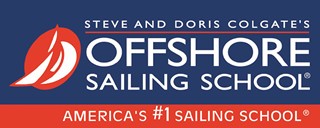
Get Started:
Call: (888) 454-7015.
Request a Quote
- Private Sailing Courses
- Learn to Sail Certification Courses
- Fast Track to Sailing
- Family Learn to Sail Programs
- Fast Track to Cruising Courses
- Sailing Lessons and Sailing Rides
- Small Sailboat Cruising Course
- Online Learn to Sail Course
- Live Aboard Cruising Courses
- Bareboat Charter Courses
- Catamaran Cruising Courses
- Ultimate Cruising Course
- Big Boat Refresher
- Maneuvering Course
- Women-Only Sailing Programs
- Navigation Courses
- Performance Sailing Courses
- Fast Track to Sailboat Racing Courses
- Performance Racing Clinics
- Coastal Passage Making Courses
- Offshore Passage Making Courses
- Celestial Navigation Courses
- Powerboat Courses
- Sailing Certifications
- Top 10 Tips for Learning How to Sail
- Safety and Comfort Aboard
- Sails & Sail Trim
- Steering and Maneuvering
- Handling Spinnakers
- Engine Maintenance
- How to Become a Sailing Instructor
- How to Choose a Sailing School
- Yacht Lease Management Opportunities
DOCKING UNDER POWER
In this sailboat docking video, Offshore Sailing School Founder, Steve Colgate, shows you the best way to dock under power. This simple system gives you excellent control whether you are sailing with others or single-handed. Here are some helpful hints on how to dock a sailboat:
- Set up your aft amidships spring line first
- Power into the dock very slowly
- Drop the spring line over a piling or cleat
- Power against the spring line to stay tight to the dock while you put all the other lines ashore
Want to learn more about how to dock a boat? In Offshore Sailing School’s Fast Track to Cruising , Live Aboard Cruising and Bareboat Charter Courses you learn about docking in different wind directions, and how to handle your boat in tight spots in crowded marinas.
HOW TO SPRING OFF OF A DOCK
In this video, you learn how to use spring lines on a sailboat to get out of a tight spot when the wind is pushing your boat onto the dock. Here are some helpful hints:
- Double up on the bow line and double back on the forward spring line by running each of these lines from a bow cleat and stern cleat, around a piling on the dock, and back to the cleat again
- Put the engine in reverse and bow will pivot out
- Make sure you have someone with a roving fender at the stern to protect against hitting the dock
- As you drive forward, clear the aft-leading spring line, then the stern line, and next the bow line by releasing the top part of the line on the cleats as you drive straight forward
- Be prepared to release both ends, in case one end gets caught on the dock
Want to learn more boat docking techniques and other sailing basics? Take our Fast Track to Cruising Course and gain confident techniques for docking a big cruising boat in multiple wind and current conditions.
The Colgate 26 is used in all Learn to Sail, Performance Sailing and Racing courses. Designed by Steve Colgate and naval architect Jim Taylor, the Colgate 26 is a popular high performance keelboat, used to train plebes and cadets at the U.S. Naval and Coast Guard Academies, great for club racing and daysailing. Read more…
Newsletter Signup
The Offshore Sailing School newsletter is emailed weekly to anyone interested in learning more about sailing and boating. It is packed with sailing and boating news, how-to tips, upcoming programs, contests and special deals.
CONTACT INFO
Toll-free US and Canada: 888.454.7015 Local and International: 239-454-1700
6338 Presidential Court, #201 Fort Myers, Florida 33919
© 2024 Offshore Sailing School - Official Site. OffshoreSailing.com is managed by Offshore Sailing School. Please report any issues to Offshore Sailing School.
- Privacy Policy
- Fast Track to Sailing | Beginner to Advanced in Six Days
- Fast Track to Boat Handling & Docking
- Catamaran Refresher & 114 Endorsement
- Docking Refresher Course on a Catamaran or Monohull
- IPC Prep With Cruising Certification & Catamaran Endorsement
- Private Courses
- Women’s Sail Sip Spa Week in the British Virgin Islands
- Top 10 Tips Learning How to Sail
- Team Building Programs
- Bookstore New!
- Captiva Island
- St. Petersburg
- Fort Myers Beach
- Scrub Island
- St. Lucia & Windward Islands
- St. Martin & Leeward Islands
- Greece Ionian Islands
- Sicily In The Aeolian Islands
- Dubrovnik-Montenegro Flotilla Cruise
- Italy’s Amalfi Coast Flotilla
- TESTIMONIALS
- News, Specials & Events
- Offshore Sailing School Returns to Captiva Island, Florida
- Sailing – Out & About SWFL
- America’s Cup Endeavor Program Videos
- Growing Up Moorings
- Doris Colgate Sailing Clinic & Cup
- Steve Colgate Inducted Into National Sailing Hall of Fame
- OSS Student Proposes During Course
- Steve Colgate and National Sailing Hall of Fame
- St. Lucia and Windward Islands Flotilla Cruise
- Weathering Unexpected Bad Weather
- A Sailing Adventure He Still Can’t Believe Was Real
- 2016 Croatia Flotilla Cruise Diary
- How We Teach
- Steve & Doris Colgate
- Steve Colgate
- Doris Colgate
- Management Team
- Employment Opportunities
- Our Mission
- Our History
- Alumni Benefits
- Awards & Accolades
- Our Philanthropy
- Certification Levels
- BOOK FLOTILLAS!
- REQUEST A QUOTE

- Find A School
- Certifications
- North U Sail Trim
- Inside Sailing with Peter Isler
- Docking Made Easy
- Study Quizzes
- Bite-sized Lessons
- Fun Quizzes
- Sailing Challenge
An American Sailing Association Educational Series
Learn how to dock a sailboat under sail, or under power, in a variety of different scenarios. Sailing legend Peter Isler walks us through the process using animations, illustrations and live action footage. Understand the techniques and skills required by both skipper and crew in order to make your docking experiences safe and easy. The videos are based on the learning material featured in the ASA textbooks Sailing Made Easy and Basic Cruising Made Easy .
This Series Features the Following Lessons:
Docking Under Power

Cruising Catamarans
It's time to apply the skills we learned in the docking drills video to returning your boat safely to the dock. As we've learned every boat and every docking situation is different so let's keep things simple for our lesson on bringing the boat back into the dock. To solidify your fundamentals practice on a day where there is a light wind that's aligned parallel to the dock. We will make an upwind approach - that is always preferred - and the dock will be on our port side.

Open Water Drills
Docking a larger sailboat under power can be challenging. This episode features great open water drills to reveal characteristics of your boat that will help you learn to maneuver in tight quarters with control and confidence. Understand how a sailboat behaves at slow speed and in addition to the rudder learn about other turning forces - such as the wind, prop walk, and prop wash.

Returning to the Dock

Departing from the Dock
It's time to apply the skills we learned in the docking drills video to getting your boat out of a slip safely. Bear in mind every boat and every docking situation is different. But if we keep things simple, success is a sure thing! For your first attempts, find a slip that is aligned bow to the wind. Learn how to configure your docklines for a simply departure, make sure your crew is safely aboard, and use your engine to control your speed in order to make a smooth and safe departure.
Docking Under Sail
An ideal approach.
What is the the ideal approach for docking a sailboat under sail? In a perfect world the wind will be blowing parallel to the dock so you can approach on a close reach and tie up pointing into the wind. Learn how to prepare your crew for docking, how to safely control your speed on your approach to the dock, how to safely step off the boat onto the dock, and finally how to secure your boat once you have docked.

The Downwind Approach
A good sailor must know how to dock their boat in all types of conditions. Although docking under sail in a downwind scenario isn’t desirable and should be avoided, there are situations that mandate such a skill. Learn the correct steps and methods to adhere to as you steer the boat into a downwind slip.

BONUS: How to Hang Your Fenders
Tying off fenders is something we have to do all the time so how should they be hung and how should you tie them? Different situations call for different applications, but generally speaking the best thing to do is hang the fenders from amidships from the lifelines just kissing the water.
The “Docking Made Easy” videos are presented by Cruising World in association with Beneteau America.
Other Docking Related Resources

Bite Sized Lesson Videos
We know that learning to sail can be overwhelming and there is a lot to take in. In an effort to help we’ve created a series of “Bite Sized Lessons” taken straight out or our textbooks.

Knots Made Easy Videos
There are as many sailing knots as there are stars in the night sky — or so it seems. But the reality is that most sailors can get along with only knowing a few, as long as they’re the right ones.

Sailing Challenge App
A cutting-edge, mobile gaming app designed as a fun learning aid to help illustrate the principles of sailing in a rich interactive and entertaining format. Available on iOS & Android.

- Learn To Sail
- Mobile Apps
- Online Courses
- Upcoming Courses
- Sailor Resources
- ASA Log Book
- Bite Sized Lessons
- Knots Made Easy
- Catamaran Challenge
- Sailing Vacations
- Sailing Cruises
- Charter Resources
- International Proficiency Certificate
- Find A Charter
- All Articles
- Sailing Tips
- Sailing Terms
- Destinations
- Environmental
- Initiatives
- Instructor Resources
- Become An Instructor
- Become An ASA School
- Member / Instructor Login
- Affiliate Login

How to Dock a Sailboat

Last Updated by
Elizabeth O'Malley
June 15, 2022
Learning how to dock a boat might be the hardest thing for a sailor to do, but it's all about planning, preparation, and practice. Relax, you got this!
When docking, you’ll want to have all lines prepared, have a plan for your approach to the dock, assess the current and wind direction and speed, proceed slowly, and let the wind and water do most of the work. You can gently correct as you go. When alongside the dock, secure the boat properly.
That’s docking from a 30,000’ view, but there’s a heck of a lot of nuance to safe and successful docking. Getting yourself (and crew) mentally prepared for docking and making sure that your boat is properly equipped for a hassle-free, incident-free docking experience are key aspects of safe, stress-free docking. Knowing the ropes (when it comes to docking) means more than just handling lines; it’s a mental game paired with the physical setup of the boat and assessment of the environment in which you’re docking.
Over the years, I have gained more confidence when it comes to docking and I attribute it to one thing: a lot of practice. For people with a ton of boating moxie and bravado, I’m probably a bit of a docking dork. I am very, very cautious and extra diligent in my preparation for docking situations. In the end, it’s what makes me feel slightly confident that I can handle the situation safely and, dare I say, serenely for the benefit of my family and friends. Over the years, I’ve seen so many stressed out docking scenarios play out from husbands screaming at wives and children, first-timers-on-a-boat stepping off with hands or heads shaking swearing never to get on a boat again, broken arms and horribly scarred, barnacle-blasted legs. It just isn’t something that I’m going to take lightly and, on that note, let’s talk about the mental game I suggest for docking.
Table of contents
Mental Preparation for Docking a Boat
My father, a former Navy fighter pilot, says that landing on an aircraft carrier is better termed a “controlled crash.” I feel that the same phrase applies to docking a boat. He shares further that, in Vietnam, when flight analysts attached sensors to pilots’ bodies to assess stress levels, aviator stress peaked when it came time to land on the aircraft carrier. Yes, pilots experienced an even higher level of stress than when flying over enemy lines, taking fire from land-based artillery, and even during dog fighting with enemy jets. Aircraft carrier landings were the scariest part of flying in Vietnam. I feel docking is quite similar.
Every time, and I mean every time, that I know I am going to have to take the boat to a dock, my stress level starts to ramp up with each approaching moment. Truly, I dread it. From my concern for my crew/s safety (and my own) to my concern for the boat itself to, yes, I admit it, concern for my delicate ego, I very much dislike the idea of docking (and will drop anchor as an alternative quite often!). But if you own a boat, there’s really no getting around having to dock now and then, so a while ago I took it upon myself to “master” docking. And while I’m still no master, my stress level doesn’t ramp up as it did before because of the mental confidence I’ve gained from studying, preparing, and practicing boat docking.
I contend that the best mental preparation is to have a healthy appreciation for the dangers involved with docking and respect those dangers accordingly. This is not a situation in which you want to “wing it.” To go confidently into a docking scenario, whether as captain or crew, first take note that this is a highly “situational awareness” event that requires focus and decisiveness. It’s not the time to be working on anything else but the task at hand. By its very own nature, docking requires multi-tasking ability so push all extraneous considerations besides docking out of your head. Stay on task!
As you’ll hear my say about other boating situations that are especially wrought with hazards (i.e. galley cooking on a gimbal stove), practicing – over and over in ideal conditions is the best confidence builder and leads to the sort of zen calm that is highly suited for boat docking. Again, a flying analogy: Commercial pilots are tested repeatedly each year on what to do in emergency situations. They memorize and practice checklist after checklist for myriad emergency situations which are most often take off and landing scenarios. Properly trained pilots (and by properly trained, I mean going to repeated simulator classes whereby emergencies are played out for pilots to learn to almost go into “auto pilot” mode in a highly stressful situation) are the best pilots. Properly trained sailors are most likely going to be the best dockers on the water.
So, you’ve acknowledged just how important it is to become proficient and confident about docking and you’re ready and willing to do the training, practicing as often as you can in varying conditions, what else do you need to do to prepare? I’d say know and fully prepare your docking equipment.
Key Terminology for Docking a Boat
There are some terms that go along with equipment and gear for docking a boat and I’m going to cover them briefly now:
- Amidships: This is the middle point of your boat from bow to stern. This is an important area for docking as it relates to the placement of the spring line/spring loop.
- Buoy: Buoy is another name for a fender or bumper -- and is used to refer to the ones that are round and not cylindrical.
- Cleat: A cleat is a simple piece of hardware designed to secure a boat by wrapping a line around the cleat. Like fenders, they come in a huge array of sizes. Cleats are affixed to a boat in several places depending on the length of the boat. Typically, there is a fore and aft clean (on both starboard and port sides of the boat). There may also be amidship cleats, halfway down the side of the boat. Cleats are also located on the dock or pier so that boats can tie up alongside the fixed structure. I believe that, when docking, cleats are a sailor’s best friend.
- Fender (or bumper): Fenders are used on recreational boats of all sizes and, accordingly, fenders vary in size from small (about 12 inches long) to very large (7 feet long). They are placed between the boat and the dock, pier, jetty, etc. to absorb the energy derived from the boat’s motion, keeping the boat from bumping into the stable, affixed object (dock, pier, jetty).
- Prop walk: When a boat reverses, it will tend to turn one direction or the other. What direction it tends to turn is determined by whether the propeller spins to the right or left. Overwhelmingly, propellers spin to the right, which determines that the boat’s stern will go left in reverse. Prop wash is one way to determine if your boat’s propeller is typical (right turning) or atypical (left turning).
- Prop wash: Prop wash is one thing that happens when a propeller is engaged. The moving propeller disturbs the water and pushes it a certain direction (depending on what direction the prop is spinning). On a boat, it’s possible to view the prop wash. For docking purposes, it’s important to know if your engine is a right hand or left-hand drive. And you can and should determine this (in advance) by looking at prop wash when you are at the dock: While tied to the dock, throttle the engine lightly to forward. Look into the water, on either side in the amidships area, and locate the agitated water. (Prop wash agitates on one side, so the other side should be calm.) If water on the starboard side is agitated, your propeller turns to the left. This means too that your boat reverses to the left. If water is agitated on the port side of the boat, the propeller turns to the right. A right-turning propeller, reverses to the right (starboard). Knowing and determining prop wash informs you of your propeller’s turning direction which is key information for docking.
- Spring line/spring loop: Spring lines reduce the movement of the boat in fore and aft directions. While they originate from similar locations of the bow and stern line, they are different lines than the bow and stern lines. Spring lines run from the bow to the stern. The forward spring line runs from an aft cleat forward toward the amidships area of the boat. Conversely, the aft spring line runs aft – from the bow back towards the stern.
With these terms in hand, let’s now turn our attention to setting the stage for docking a boat. Let’s talk about the equipment and gear you need to have ready.
Equipment and Gear Preparation for Docking a Boat
In this section, we’re going to look at several specific items to properly put into place for a prepared docking plan. They include fender placement, line set up, and throttle sensitivity.
Fenders and Buoys
What a great invention is the boat fender! Saving so much wear and tear on a boat, the use of multiple fenders or buoys on a boat is something about which I am quite keen. I prefer at least three including a stern, bow, and amidships fender and, truly, I am extra partial to the use of a buoy rather than a fender. “Stand-o” which is the amount of space between the hull and the object to which the boat is tied increases with the use of a buoy versus a fender. This extra space, at least in my mind, translates to extra protection for your hull.
Buoys and fenders should be secured to the boat via either a cleat or the base of the railing’s stanchion (not the horizontal railing or the top of the vertical stanchion).
The location of the fenders/buoys (relative to the water and the dock) is crucial. When placing your fenders, pay attention to the height of the dock and place the fenders accordingly. Take into account whether or not the dock is floating or affixed. A fixed dock is best managed with a horizontal fender. Lastly, depending on whether you are tying your fender to a cleat on the boat or the railing stanchion, you will want to use a cleat hitch or a slip hitch to secure it.
Spring Lines or Spring Loops
A spring line, as noted earlier, runs from either end of the boat to the other. Aft spring lines run from the aft cleat to the amidships cleat and they should not be taut. Rather you want them hanging down to the point where the line almost touches the water. The forward spring line is secured at the bow cleat aft to the amidships cleat, again, hanging just above the waterline. The goal is to have enough line to be able to lift it up and lay it over the dock cleat once the boat is very nearly touching the dock and slowed almost to a stop. It is recommended that a spring line be the length of the boat.
When putting your spring lines in place prior to starting any docking activity be sure that the spring lines are on the outside of the railing and railing stanchions. As with all lines, make sure that your spring lines are in good shape – there’s going to be steady strain on them when you are using them to make a smooth docking maneuver.
Throttle Sensitivity
Being familiar with exactly how sensitive your throttle is really helps your control in the often tight maneuvering that occurs during docking. Take the time to see just how much it takes to move your boat with a touch of the throttle. Slight, minimum motions are the way to make adjustments to your boat’s position. Take note that even once in neutral the boat will continue to move in the most recent throttle position’s direction. Short, little bursts with the throttle are key, and using neutral between forward and reverse is also vital. This is both from a control perspective as well as damage to the transmission considerations.
We’ve covered a lot of material here! And we haven’t yet gotten into the actual nuts and bolts of the process of docking. Before we go to the next two considerations in how-to-dock (environmental assessment or situational awareness preparation and people preparation), I wanted to ensure you’re mentally prepped and equipment-savvy. Solid preparation in these two areas set you up nicely for the next areas of consideration. As you can tell, and likely know from some experience, docking is a complicated task, much harder, I believe than anchoring. Maybe it’s the challenge of positioning yourself to a fixed object – or, for me, the added pressure of all those eyes that could be watching. Whatever the case may be, by the end of this article, you’ll be better prepared and equipped to take on the daunting dynamics of docking.
Environmental Preparation for Docking a Boat
Taking a thorough assessment of a variety of conditions that are playing into the specific docking scenario you’re encountering is a vital step in executing a smooth docking of your boat.
First know about the built space. Is it a busy or tight marina or gas dock? Are the docks fixed or floating and at what height? This will affect the placement of our fenders for maximum protection. What condition are the docks in? Are they prepped with dock bumper strips or in bad shape and looking pretty iffy? Knowing what you’re dealing with in the physical environment can help you prepare yourself and crew by pointing out these areas of concern.
Second, take note of the immediate conditions relative to tide (high or low or slack), current (which direction is it running and is it a fast current or slow), and wind direction and speed. Even though you’re likely going to be under power, the wind is certainly going to play a role in your docking decision. WInd pushes boats and, if it’s blowing even a few knots, wind can swing your bow around pretty darn fast. Same goes for current and it can push the entire boat in one direction. The interplay of current vs wind is a dynamic for which you need to plan.
Crew Preparation for Docking a Boat
There’s nothing worse than being on a boat with a helmsman screaming things at you and other crew members as their stress level rises during docking. Do yourself and your crew a favor and remain calm. And communicate.
Before docking begins, take some time to walk your crew through what the plan is. Help them understand that the wind and current will impact the way the boat moves. Ensure it is very clear that they are not to wildly jump aboard the dock and try to catch the boat as it moves alongside the dock or slip. Make sure they understand the importance of keeping all limbs and digits inside the boat.
Maneuvering During Docking a Boat
The thing that has helped me the most with docking is to know and understand the help (or hindrance) that the wind and current play in the process. Truly, these two factors can account for probably 50 to 75% of the boat’s motions when the boat is going as slow as it should be going when docking.
Speed of the boat is a huge consideration and you should never be going at a speed faster than the speed you’re willing to hit the dock. In other words, slow down the speed of the boat well before you get to the docking zone.
With your engine in neutral at a slow speed, you should be able to quickly tell what the wind is doing and what the current is doing to the boat. Very, very small adjustments of forward and reverse (the other 50 to 25% beyond wind and current) are your friend when docking. Alternating between forward and reverse with mild wheel or tiller corrections, at a slow speed allows you to quickly see how the boat is responding to all the factors impacting it: current, wind, engine thrust, and wheel/tiller direction.
As you approach the dock or slip, several boat lengths out, begin your turn and remember you are going slowly. See how things are going and do not be shy or embarrassed about doing a fly-by of the dock to gain a better assessment of the environmental situation. Granted, this is much harder to do when going into a slip (either in forward or reverse) but if you sense the need to abort the docking mission and try again, do it. (Special note: Unlike cars, boats pivot and what a bow will clear a stern will hit. You’re going to have to be looking back and forth bow to stern constantly to monitor how the boat is pivoting and what the stern may encounter that the bow cleared.)
As your boat responds to the wind, current, engine direction and speed, and the direction of the wheel or tiller, and you are approaching the dock, you’ll have the comfort of knowing that your fenders/bumpers and spring line(s) are in place. Moving ever so slowly and watching wind and current interplay, as you’re heading into the wind, the boat will ideally glide gently up to the side of the dock at which time, you or your crew member can toss the spring line (that has plenty of slack in it) over a cleat and the line can then be pulled taut to bring the boat alongside the dock.
Whew! Your crew (or you) then steps on to the dock and secures the rest of the lines. Give yourself a quick pat on the back and know that because you did plenty of advance preparation, you were certainly in far greater control of the situation than winging it.
Because there’s just so darned much to cover when it comes to docking a boat, if I had to distill this article into a 60-second explanation to someone, I’d essentially say this:
- Make sure your on-board equipment is squared away.
- Decide how you will approach the dock, having already assessed the environment at the dock. Hello, current! Howdy, wind!
- Don’t rush! Slow and steady is the key. Small movements and small throttle thrusts can do the job.
- As you approach the dock, let nature’s forces (wind/current) manage most of the action and then gently correct with throttle and wheel.
- Once alongside, ensure your boat is secured properly.
As I said earlier in this article, there is just no substitute for practice. I’ve made some boat and aviation comparisons, not any boat and automobile comparisons; however, there are two things that come to mind.
Docking a boat has similar (greater!?) stress than parallel parking. And the best way to learn to parallel park a car is, you guessed it, by practicing over and over again. So either get out there and do the practice early on just like you did when you had your learners permit. Also, most of us took driver’s education in school, and I highly encourage sailing folks to either attend a sailing course or watch as many videos as possible for a DIY version. In certain areas, you can find sailing courses that will dedicate an entire day (or more) to the ins and outs of docking. While I have not taken a docking-specific daylong sailing course, I wish I had. My two very good friends who have done courses like this (and they did separate ones with one on the east coast and one on the west coast) and their several hundred dollar investment is telling. They are hands down two of my most favorite people to sail with and to have aboard my own boat. Both courses were offered by ASA which usually gets very good reviews for their courses.
Docking is my least favorite part of sailing, except for the constant stream of dollars tossed into the hole in the water. Unlike the money pit though, I do think it’s possible to become much more confident and competent via practice and preparation. I wish you the very best in all of your docking scenarios!
Related Articles
Elizabeth has sailed Sunfish, Catalinas, Knarrs, and countless other boats. Forty years later, she finds herself back on the waters of Bogue Sound, where she lives and sails with her daughter, Morgan, and chocolate lab, Choco.
by this author
Most Recent

What Does "Sailing By The Lee" Mean?
Daniel Wade
October 3, 2023

The Best Sailing Schools And Programs: Reviews & Ratings
September 26, 2023
Important Legal Info
Lifeofsailing.com is a participant in the Amazon Services LLC Associates Program, an affiliate advertising program designed to provide a means for sites to earn advertising fees by advertising and linking to Amazon. This site also participates in other affiliate programs and is compensated for referring traffic and business to these companies.
Similar Posts

How To Choose The Right Sailing Instructor
August 16, 2023

Cost To Sail Around The World
May 16, 2023

Small Sailboat Sizes: A Complete Guide
October 30, 2022
Popular Posts

Best Liveaboard Catamaran Sailboats
December 28, 2023

Can a Novice Sail Around the World?

4 Best Electric Outboard Motors

How Long Did It Take The Vikings To Sail To England?

10 Best Sailboat Brands (And Why)
December 20, 2023

7 Best Places To Liveaboard A Sailboat
Get the best sailing content.
Top Rated Posts
Lifeofsailing.com is a participant in the Amazon Services LLC Associates Program, an affiliate advertising program designed to provide a means for sites to earn advertising fees by advertising and linking to Amazon. This site also participates in other affiliate programs and is compensated for referring traffic and business to these companies. (866) 342-SAIL
© 2024 Life of Sailing Email: [email protected] Address: 11816 Inwood Rd #3024 Dallas, TX 75244 Disclaimer Privacy Policy
- Skip to primary navigation
- Skip to main content
- Skip to primary sidebar
- Skip to footer
Sailing Eurybia
Two Humans and a Dog sail Mexico on a Sea Maid Ketch
Tips for Docking a Sailboat Safely and Confidently
April 18, 2019 10 Comments
I grew up in a sailing family. I learned by example from my dad, then by experimentation after that. Since our early boats had no engines (nor did they go in reverse!) I did not learn about docking except how to sail a tiny light boat up to a dock and turn into the wind. Not much use for our 32,000 pound 45’ boat! Ever since I had been docking by winging it – and sometimes winging the bow pulpit. I successfully docked in most situations, but it was always nerve-wracking.
Finally I have had an opportunity to change that. I took my first ever ASA class here in San Francisco and learned techniques I would not have thought of, plus got confidence by doing it myself. The Advanced Motoring & Docking class as taught by Tradewinds Sailing School in Richmond, CA is fabulous. At first I thought it seemed expensive at $325. However it’s a full day on the water and the in-person instruction was fabulous. There were just two of us in the class and we used a Jeanneau 43 for the day. I learned so much about controlling the boat in tight quarters WITHOUT jumping off the boat or doing other dangerous and unnecessary actions. Although they test on the ASA information, they also introduce their own methods which, I have to agree, seem far better than the traditional approaches.
I will share with you some of the information I learned, but of course my notes are only to pique your interest and maybe give you some hints for your own docking. I strongly recommend that if this interests you that you find a course yourself, but you might ask if their methods require jumping off the boat to catch lines when docking. Tradewinds methods have convinced me that this is a dangerous and unnecessary practice, despite being the most commonly seen. Tradewinds trains you to stay on the boat, keep the boat under control, and step off the boat to tie dock lines only when the excitement has ended, the boat is stopped, and it is safe to do so slowly.
Motoring Concepts
Moving a boat under power has six elements that you have to balance or learn to work around. Wind and Current clearly can affect how the boat behaves. Prop Walk and Prop Wash are two ways that the boat’s motion is affected by the propeller action. And finally Momentum (how much way you have on) and Inertia (the tendency to keep moving in the direction you are already going, even when the engine is in neutral) are two more forces that can be used as tools to controlling the boat by power. These influences are probably familiar to you but we’ll run through them quickly.
Wind and Current
Current tends to affect the whole boat, making it move downstream in generally a straight line. It can also be hard to see until you suddenly realize you are going to miss the slip you were aiming for.

Wind tends to affect the bow most quickly, making it trickier to move the bow into the wind without it blowing off. But this means that reversing into a wind is often easier than powering forward into a head wind. Useful to realize that.

Momentum and Inertia
Momentum is the amount of force your boat has based on its speed and weight. Momentum is why you want to have control over speed – as they say you should approach the dock at the speed at which you are willing to hit it. Inertia is the tendency to stay moving a particular direction. Inertia will be essential in fighting prop walk – read on!
Prop Walk and Prop Wash
Prop Walk is the tendency for the boat to turn in a particular direction when reversing. Most boats have a right-hand turning propeller which forces the stern to the left when in reverse. Left-hand propellers would do the opposite. In the following paragraphs I will default to a right-hand turning propeller but I will try to remember to put notes in parentheses e.g. (LH: steer left) for those with left-hand drive props.
How do you know whether you have a right-hand or left-hand drive? If you have tried to reverse you may have noticed that it curled off to one direction or another. But if you have a new boat then you can check this at the dock when tied off securely. Put the engine in forward with moderate throttle. On one side of the boat or another, just aft of amidships, you will see agitated water. The other side of the boat will be calmer. This agitated water is the result of Prop Wash as the propeller blasts water off the keel. For a boat propeller that turns to the right, clockwise, (when viewed from astern) the prop wash will appear on the starboard side (and your boat will reverse to the left). If you see the turbulence on your port side you have a left-hand drive, your boat will reverse to starboard, and will need to follow the (LH: xxx) instructions.
Whichever direction of Prop Walk your boat has, transitions to neutral will allow the boat to keep moving backwards without continuing to turn. Short bursts in reverse will apply more power to keep moving backwards, but once you get way on again, pop into neutral to counteract the turning.
Going into neutral allows the boat to stop exhibiting prop walk while still moving in the direction you were going the moment you slipped out of reverse.
Use Minimum Motions
Big motions get you in trouble on a boat. Tiny adjustments are often enough and easy to counteract if you went the wrong direction. A 6” turn of the wheel is plenty – do a little and watch. Likewise just changing gears is often enough, you may not need to throttle up to change the motion of your boat. Change gears first, then throttle up slowly if you still need the power. Occasionally you will need to give a burst of throttle, but it still does not need to be a large change, just quick.
Note: If you have a throttle and a gear shift (my boat has a single handle for both functions) then don’t forget: Forward – Neutral – Reverse – never go straight from Forward to Reverse, always pause in Neutral to avoid transmission damage.
Remember A Boat Doesn’t Drive Like a Car
My very first cruising boat was a homemade beauty that had some, shall we say, peculiarities. One of these was that the steering system was from a car. The steering wheel was a smallish car steering wheel and it was hooked up backwards – you turned left to go right – sort of like a tiller. Boy did I get confused when trying to back up! I assume you don’t have this issue on your boat. However notice that this entire article assume you have wheel steering. For tillers a right rudder is effected by turning the tiller LEFT, whereas a steering wheel (usually) is turned right to effect a right rudder.
In some ways a boat DOES turn like a car: When you are going forward (assuming sufficient speed) and turn the wheel to the right your boat starts a right turn in a gentle arc. If you were to reverse (assuming sufficient speed) it would follow that same arc in reverse (until you slow enough for prop walk to affect your boat’s motion).

Whether going astern (with sufficient speed) or ahead the boat tends to travel along an arc. The left image above shows the path when the rudder / wheel is turned left and the right image shows the path with right rudder / wheel.
However, unlike a car, a boat turns about a pivot point aft of the main. So when the bow moves to the right in a turn, the stern is swinging out to the left.

If you’re turning a boat your stern can hit a pillar which the bow cleared just fine – check your stern and turn when it is safe for the stern to swing out.
Also be aware of Advance which is much greater in a boat than in a car. Advance is the distance before the opening that you need to start your turn (when entering forwards). Our instructor told us that for the 43’ boat we were sailing that we needed to start the turn into the slip about 62’ out – about 3 of our marina’s 21’-wide slips before the slip we were going into. Remember that the helmsman determines when to start turning so the advance distance is properly the horizontal distance from the helm station to the center of the slip you are going to.

Other sources say to turn when the opening is 30 degrees off the direction of your boat. Try these methods until you are comfortable turning into your home slip and you can estimate a similar distance or angle when going into an unfamiliar marina.
Docking Techniques
Note that these docking techniques are different than most of us are taught in two ways:
- no one jumps off the boat until the boat is stopped next to the dock
- you do not throw lines to people on the dock, instead you stay in control until stopped then step off the boat
This may be heresy to you and other captains you sail with, but it is much safer for both your crew and your boat.

Some Techniques to Practice
If you think of docking as being done 75% in neutral you won’t be far off. Neutral has the great advantage of taming prop walk and utilizing momentum effectively. Of course you have to use forward and reverse to get anywhere, but think of forward and reverse as momentary “correctors” that just increase your momentum or change your direction.
In some of these maneuvers you will want to have a “loop” prepared to help control the boat when you arrive. An aft spring loop will be a mooring line secured at your aft cleat and your waist (midships) cleat with enough slack to nearly touch the water. It will be used when heading forwards along a dock.
A forward spring loop is similar – a mooring line secured at your bow cleat and your waist (midships) cleat with enough slack to nearly touch the water. It will be used when backing onto a dock. In both cases you want there to be enough slack that the crew can pick up the slack in two hands and toss it over a cleat on the dock when the boat is nearly stopped and in good control close to the dock. The boat will back down (forward spring loop) or move up (aft spring loop) and get sucked into the dock with no need to use (unreliable) bystanders or dangerous leaps to shore from a moving boat. See more detail in Parallel Approaches below.
Back-and-Fill or Standing Turn
A standing turn, changing direction or “spinning” in place, also called Back-and-Fill is a useful technique. You can practice this is an open area, or for best results, in an empty mooring field where you can really mark your starting position. For a RH Drive boat you will put your wheel all the way to the right (LH: Left wheel) and lean against it to hold it in place – you will not be turning the wheel again until you’re done . Go forward and proceed slowly on your turn. When you are starting to move away from your starting position, go into reverse, where you will be helped by prop walk as well as the rudder angle. Once you start to go backwards rather than just turning, shift back into forward and continue alternating forwards and reverse until your boat is facing the new direction. Straighten your wheel to proceed.

The Standing Turn or Back-and-Fill. The dark line out the back represents the rudder/wheel position and the pink arrow indicates direction of travel. By alternately reversing and going forward you can turn your boat in place.
Where do you use this?
- preparatory to backing into your slip
- turning in a fairway when you are headed the wrong direction (oh – the fuel dock is over THERE!)
- any time you need to turn the boat around and have limited space to do it
- showing off for your friends
Perpendicular Forward Approach
Say you are approaching the fuel dock. It is directly in front of you. You are going to need to turn to come parallel to it. How close do you get before turning? A rule of thumb is approach until the bow of your boat appears to be at the same level as the dock you are approaching. This is a rough guide, but much easier than trying to guesstimate when you are, say 62’ away. Then once you are parallel to the dock proceed as for Parallel Forward Approach below.
Parallel Forward Approach
This is probably the most common way to approach a pump-out or fuel dock when there is plenty of room to do so. When you can approach from either side equally then plan to approach port side to the dock (LH: starboard side to the dock) so you can use prop walk in getting off if needed. Prepare an aft spring loop on the port side (LH: starboard side) as described above. Approach slowly in forward gear from a ways out, turn 30 degrees to the dock until you judge you are getting close, then straighten the wheel. You should be in neutral by now. Make adjustments (reverse if you’re going too fast, forward if you’ve lost way) and slow down until you are stopped or nearly stopped a few feet away from the dock. Ask the crew to toss the aft spring loop onto a cleat. Then pop into forward with very low throttle and turn the wheel away from the dock. The boat will be sucked into the dock and held there so that crew can safely and slowly disembark. If you need to do a lengthy fuel up or need to take your boat out of gear for another reason then the crew can secure the boat normally with mooring lines. Otherwise you can just stay in gear while you pump out.

Aft Spring Loop – Forward Gear – Turn away from dock
Parallel Backwards Approach
This approach is very similar to above but you will be backing in and using a forward spring loop. The preference is also to land on the port side (LH: starboard side) In this method but you can approach with either side to the dock in good conditions (little wind or current). Once the spring is deployed, pop into a gentle reverse, and you will be sucked into the dock and against the spring line.

Forward Spring Loop – Reverse Gear – Rudder not significant
You can also use this method if you are going in forward but the only cleat is ahead. Then you can use the forward spring but change into reverse and go backwards to secure yourself against the dock.
Wind Conditions
Wind on your bow is destabilizing – the bow can blow down and it is difficult to control the boat. However moving your stern into the wind is actually easier – the bow tends NOT to blow off when the stern is into the wind. You do have to contend with prop walk, but you have been given ways to deal with that.
So if you are approaching your slip on a very windy day these are the easiest ways to approach:
- back in if the wind is coming out of your slip
- go in forwards if the wind is blowing into the slip
Especially if others are watching! Why make it harder?
Backing in with wind ahead
But if you do need to back up with the wind from forward and your bow is tending to blow off, it gets confusing knowing which direction to turn. Rather than try to wrestle through the logic, just turn in the direction you DON’T want the bow to go.
If backing up and the bow starts to fall off to starboard, turn starboard. If it starts to fall off to port, turn to port. Little turns, a few inches.
Why does this work? Remember that when in reverse the stern turns to the right when the wheel is right, which means the bow turns to left.
Backing Out of the Slip – Basic
The most basic idea about leaving the slip is to plan for where you want to end up. You always want to end up on the windward side of the center line down the fairway heading towards the exit. For those with a fairway exit opposite the direction their prop walk takes them, well, you may need to back down the fairway and you should become comfortable with this. You can also use spring lines or warps to get your boat turned opposite the prop walk direction, but that is beyond the scope of this article.
Wind Coming out of the slip
The wind will assist getting out of the slip but you need to take a fairly tight turn so that you stay on the windward side of the slip and don’t blow down on the boats across the fairway. You may need a spring line on the outer leeward side of the slip to help you turn.
Wind Blowing into the slip
When the wind is blowing into the slip it’s essential to reverse a little more forcefully to get out of the slip, but you can take a wider turn so as to end up on the other side of the fairway. You will need to make sure you can get your bow around so that you don’t get blown back down onto the pilings around your slip. So as soon as you are out of the slip and are crossing the center line of the fairway forcefully turn the wheel towards the wind, shift into forward and give it plenty of throttle to get that bow moving.

I hope these notes give you a few more ways to think about docking. I haven’t talked much about using lines to further control your entry to or departure from a slip – that’s the Advanced Advanced Class! Likewise maneuvering around other boats on the docks you are approaching. But in good conditions and without other boats around these methods will work with no additional measures. So practice these docking techniques until you are confident entering and departing your slip in good conditions, and you can approach the fuel dock with confidence. Good Luck and Be Calm.
Share this:
- Click to share on Twitter (Opens in new window)
- Click to share on Facebook (Opens in new window)
- Click to share on WhatsApp (Opens in new window)
This site uses Akismet to reduce spam. Learn how your comment data is processed .
Brilliant! There is so much good information in this post – I’m so glad to see it. Would love to see your take on getting in and out of docks when maneuvering between other boats that are already tied up. Also your favorite engineless docking thoughts. But in the meantime, those spring loops really are special – wonderful to learn some new stuff about this! Cheers, Shemaya
Thank you! I’m so glad you found it useful. And yes, coming into, say, a fuel dock when there are already other people tied up would be a great follow-up topic. And engine-less docking, something we used to do frequently when we had a boat with a less reliable engine (!) is something way too few people learn to be good at. My current slip nearly always has stiff breezes straight from the Golden Gate Bridge blowing into it so I think I would have to line in for safety. Another good topic! And then anchoring under sail – everyone … Read more »
Hi Marie, All of that sounds great! I’d be fascinated to hear your take on anchoring and sailing off of anchors without motors. I’ve read various versions, and have what I do, which doesn’t necessarily match up with recommendations, but has worked for me… I haven’t actually written that up. When you say “lining in,” you mean setting an anchor so that you can let the boat fall back under control? I’d be really interested to hear details about that, especially about how you manage the anchor and line after the boat is in the slip. It’s not something I’ve … Read more »
Maybe “line in” isn’t the real term — I just meant that I’d have to use lines to control the boat without an engine if there were a stiff breeze straight into my slip. You’re right though – in severe conditions without an engine using an anchor to control your speed might work – but then you’d have to go get the anchor with the dinghy. Ok for an emergency but wouldn’t do that as a routine. But we’ve also used our (powered) dinghy on the stern quarter to move the boat when there were no winds and the engine … Read more »
Thanks for your suggestion to slightly and/or quickly adjust the steering wheel to get the desired direction instead of using big motions. My husband and I are looking into buying a sailboat this summer, but I don’t have a ton of experience with driving one. He’s been giving me a lesson or two on our friend’s boat, and I’m slowly improving, but this tip helps a lot. Once I get good at this, we’ll need to look into getting a boat and a dock so we can more fully enjoy the summer.
And heavier boats take some getting used to – you have to turn a little and wait for the boat to react. Good luck! It’s a great skill to have and makes your time on the water much more relaxed. Enjoy.
Great article. Thanks for summarizing the tricks and pointers. Very helpful
Thanks, Jim! So glad it was useful to you.
This may be the most helpful article I’ve read on sailing. You explained several things well but briefly which made it more clear. I especially appreciate the explanations of spring loops. We recently saw a boat tied up this way and we’re curious, but didn’t ask. I also very much appreciated the point that the boat should be stopped before jumping off. It’s typically just my husband & me and I am very anxious about jumping and not very good at jumping off to tie up. I feel so much better about it now and will definitely try the spring … Read more »
Thank you Greta! So great to hear that knowledge that helped me is helping someone else! I typically steer the boat just because of the jumping off thing, and my husband ended up in the drink more than once! But now we have a safer way, I’m glad you do, too.
Stay in touch - sign up for our newsletter for occasional news from Eurybia and her crew.
Your Boat Name:
Email address:
- Privacy Policy
“Live in the sunshine, Swim the sea, Drink the wild air” --Emerson
About This Site
SailingEurybia is a WordPress site. The theme is a version of the Genesis Sample Theme developed by Eurybia-Marie . ©2018
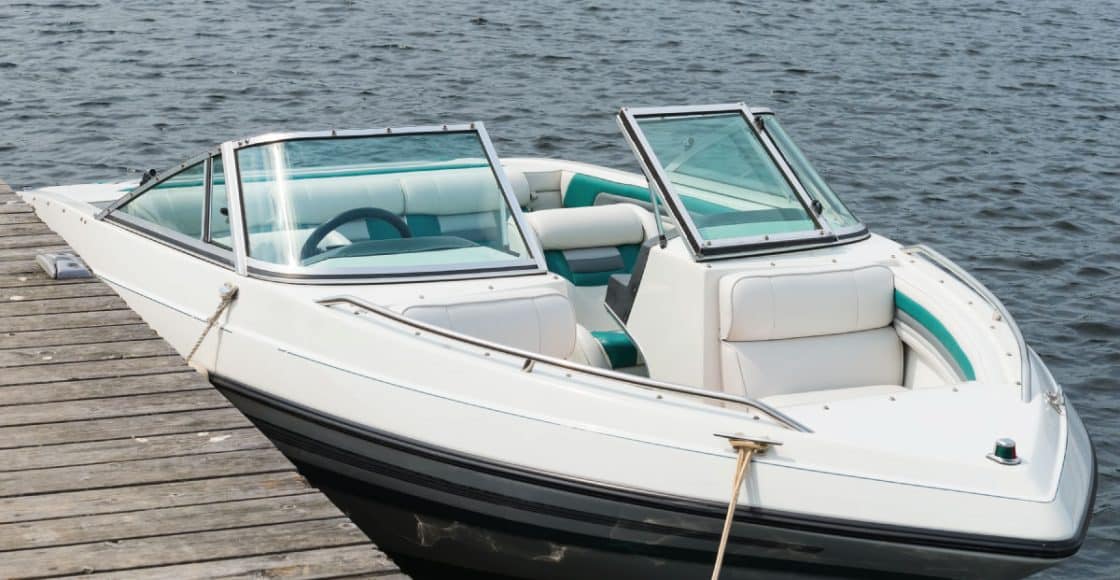
Docking a Boat: 5 Easy Steps for Beginners

Table of Contents
Last Updated on August 15, 2023 by Boatsetter Team
Learning how to dock a boat with style and confidence requires a little experience and familiarity with how your boat handles. Docking a boat by yourself or with a crew aboard becomes easier once you learn how to judge wind and currents. In this post, we’ll teach you how to dock a boat in five easy steps so that the next time you’re out on a Boatsetter rental , you can take the helm with more confidence.
- Make a plan
- Prepare the boat
- Docking with wind or current
- Approach the dock slowly
- Swing the wheel
Rent, Charter, Share— Only at Boatsetter
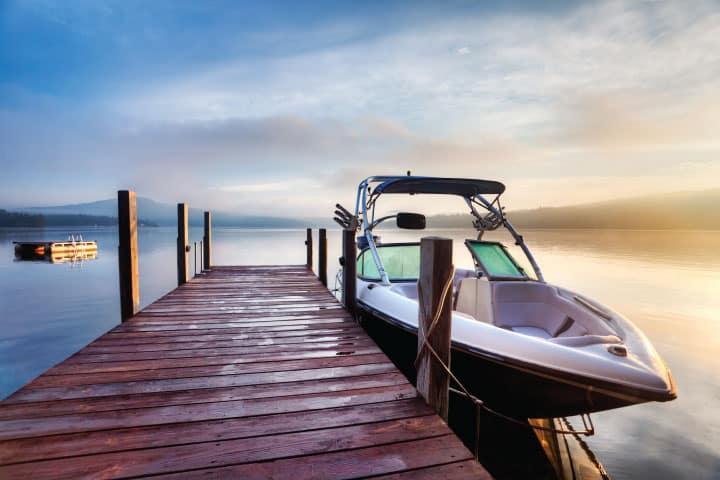
1. Make a plan
If you are unfamiliar with the dock, make a reconnaissance pass to determine how you’ll approach it. Things to consider as you prepare to dock the boat:
- The side of the boat you’ll be docking on.
- The location of cleats for tying up to the dock.
- The dock height so you can have your fenders adjusted to best protect the boat.
A fuel dock or the dock at a marina or restaurant may have an attendant who will tell you where they’d like you to tie up and will help you handle your dock lines.
2. Prepare the boat
Before you begin approaching a dock or slip, attach dock lines to a bow and stern cleat on the side of the boat that will be near the dock. Also, hang your fenders (bumpers) on that side of the boat. Now when you reach the dock, you’ll be ready to tie up.
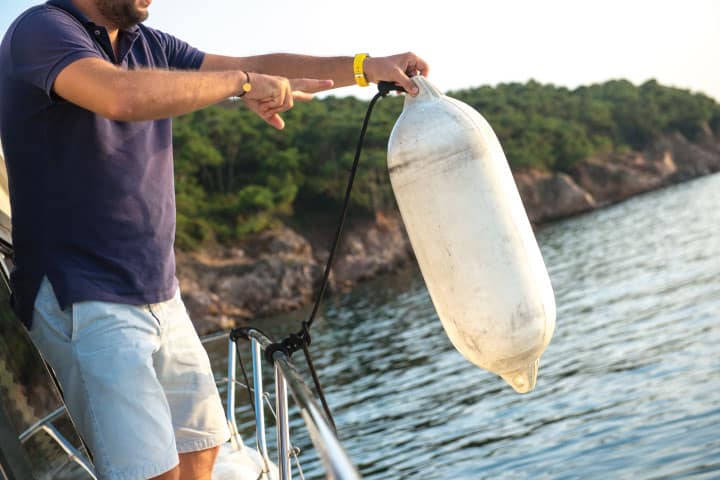
3. Docking with wind or current
Take a moment to check for wind and current that could affect how your boat will handle as you approach the dock. Flags on shore can give you a good idea of wind direction. If there’s an offshore wind, you’ll want to approach the dock at a sharper angle for best boat control, perhaps at 45 to 50 degrees. If the wind is blowing onshore, approach at a more shallow angle – 30 degrees or less – and plan to let the wind push you towards the dock.
Current can be observed by looking at dock pilings or markers– if there’s a significant current, you’ll be able to see the water flowing around the pilings or markers. Anticipate how current will move the boat as you approach the dock, and aim up-current so that you end up on target.
If you have the option, you’ll have better boat control approaching the dock into the current or wind.
READ MORE: Dock and Dine Basics: 7 Tips for Success
4. Approach the dock slowly
With wind and current in mind, begin your approach to the dock with just enough speed so that you maintain control. Take it slow; bumping the engine in and out of gear is okay. You’ll have more time to react and make decisions.
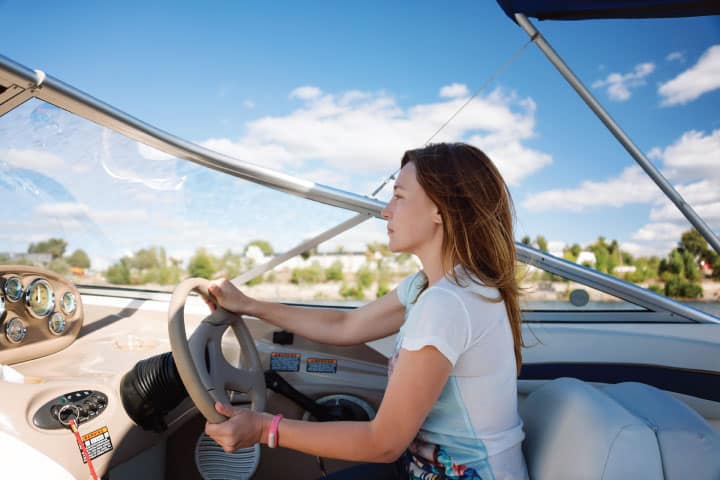
5. Swing the wheel
When the bow is about one boat length away from the dock, turn the steering wheel hard away from the dock. This will cause the stern to pivot towards the dock, closing up your angle of approach.
A smaller boat will react more quickly to this steering input than a bigger boat – after docking a few times, you’ll learn how your boat behaves and be prepared to time your move perfectly.
As the boat becomes parallel to the dock, turn the wheel hard in the other direction and shift into reverse. This will arrest the boat’s speed and pivot. If you have that on-shore wind, let the breeze drift the boat right up to the dock.
When the wind is off-shore, be ready to get a line on a dock cleat (or toss a line to the attendant) before the boat drifts off the dock.
If you find yourself out of control or position, aborting the approach is always okay. Idle away from the dock and try again. On your second approach, you may have a better idea of how wind or current is moving the boat or your ideal angle of approach and speed. Practice makes perfect! You’ll get the hang of it.
Learn how to boat with Boatsetter Academy
One sure way to get the hang of docking, among other skills, is by joining Boatsetter Academy at any one of its 16 locations. Through this 2-hour, hands-on boating course, beginners like you will build confidence and become familiar with the basics of boating. And the best part: courses are completely free!
Boatsetter is a unique boat-sharing platform that gives everyone— whether you own a boat or you’re just renting — the chance to experience life on the water. You can list a boat , book a boat , or make money as a captain .
List. Rent. Earn— Only at Boatsetter

Charles Plueddeman is a self-employed writer and photographer based in Wisconsin. A staff editor and contributor to Boating Magazine since 1986, he is the author of its “Off My Dock” column. In the marine realm he specializes in engine technology and trailerable boats. His editorial work has appeared in many national publications, including Popular Mechanics, Men’s Journal, Playboy, Popular Science, Cycle World, and Harley-Davidson Enthuisast .
Browse by experience

Explore articles

Can You Say Girls' Weekend? Your Boat Rental Awaits!
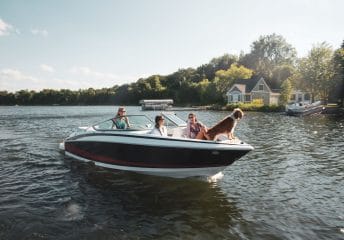
Bowriders: What is a Bowrider Boat?
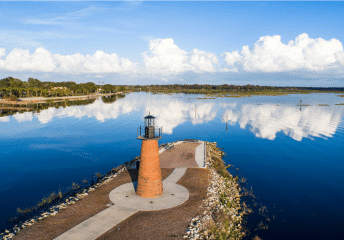
Lake Towns in Florida
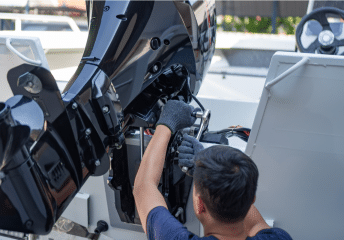
What Are Bellows On A Boat?
- 2024 BOAT BUYERS GUIDE
- Email Newsletters
- Boat of the Year
- 2024 Freshwater Boat and Gear Buyers Guide
- 2024 Boat Buyers Guide
- 2024 Water Sports Boat Buyers Guide
- 2024 Pontoon Boat Buyers Guide
- Cruising Boats
- Pontoon Boats
- Fishing Boats
- Personal Watercraft
- Water Sports
- Boat Walkthroughs
- What To Look For
- Watersports Favorites Spring 2022
- Boating Lab
- Boating Safety

12 Top Docking Tips
- By Boating Staff
- Updated: June 23, 2017
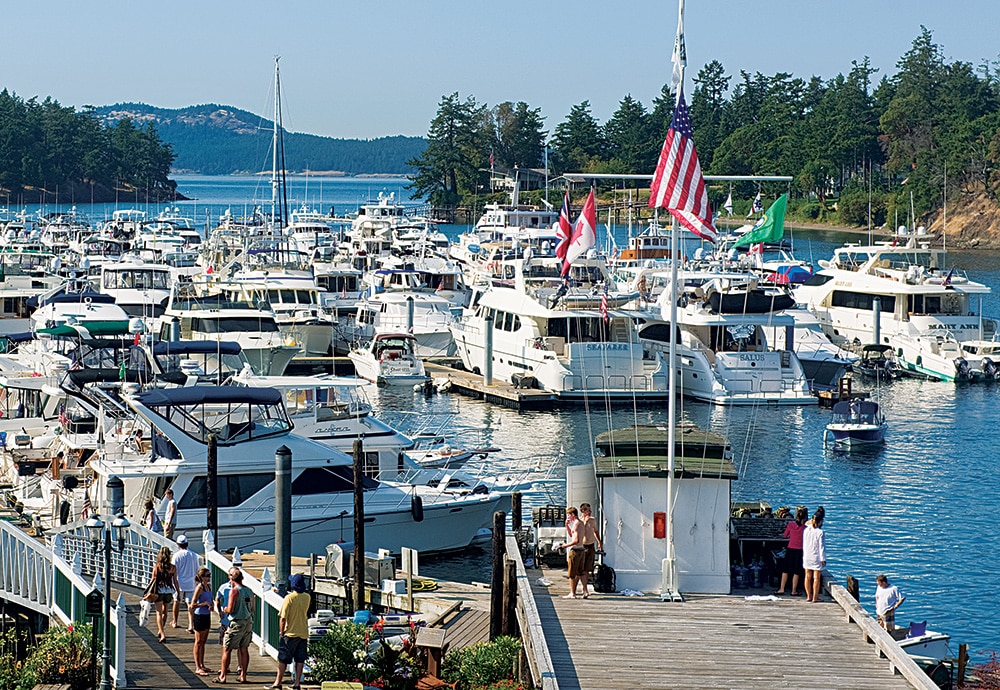
Here are 12 tips that will not only make you better at close-quarters maneuvering and docking, but will also make you a better all-around boater. Remember, the cardinal rule of docking is never approach the dock faster than you are willing to hit it.
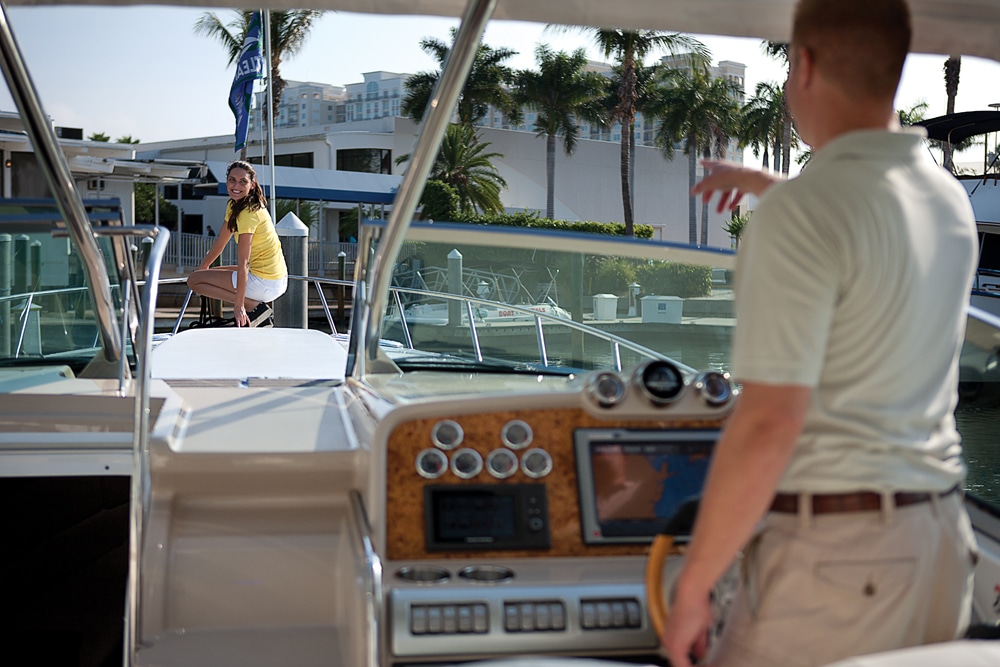
1. Come Up With a Plan First and foremost, you must be aware of how your boat handles, particularly at bare steerageway. The more comfortable you become, the more confident you’ll be when trying to slip it into a tight space in a jammed marina.
10 Simple Rules for Better Docking
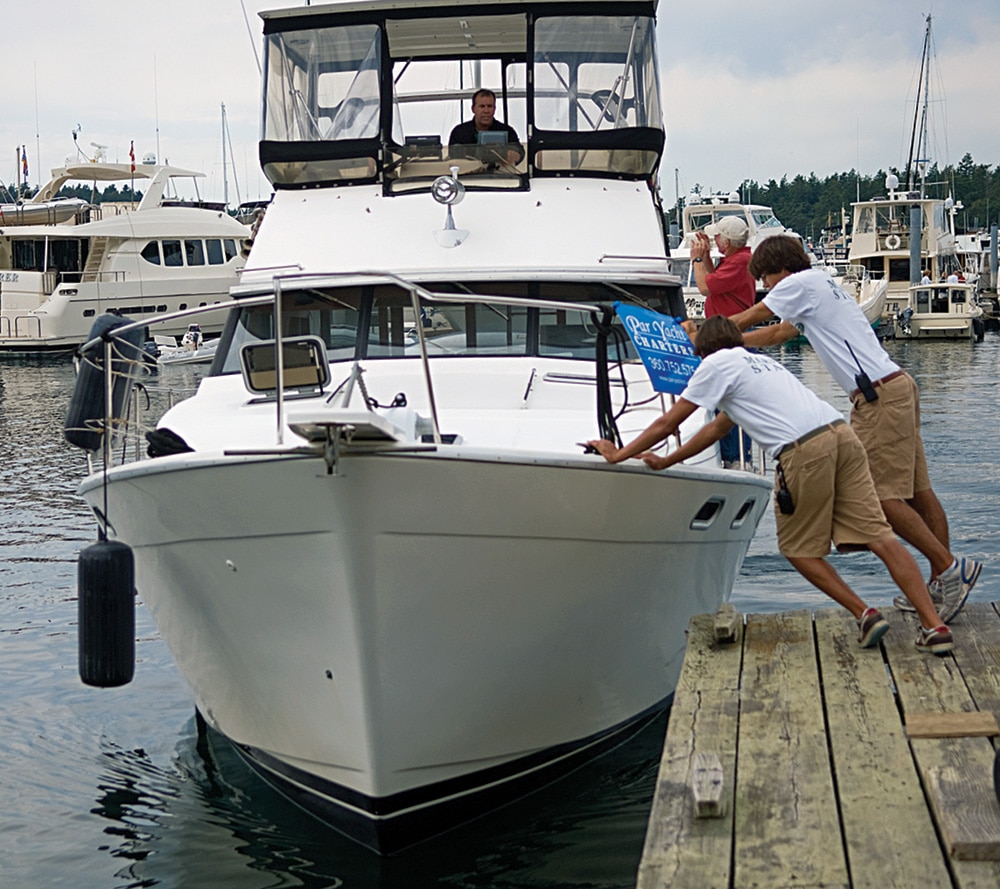
2. Learn How to Use Wind and Current to Your Advantage When docking in a tough spot, wind and current — coupled with knowledge of how they affect your boat — plus situational awareness can serve you better than an army of deck hands.
How to Use Wind and Current When Docking
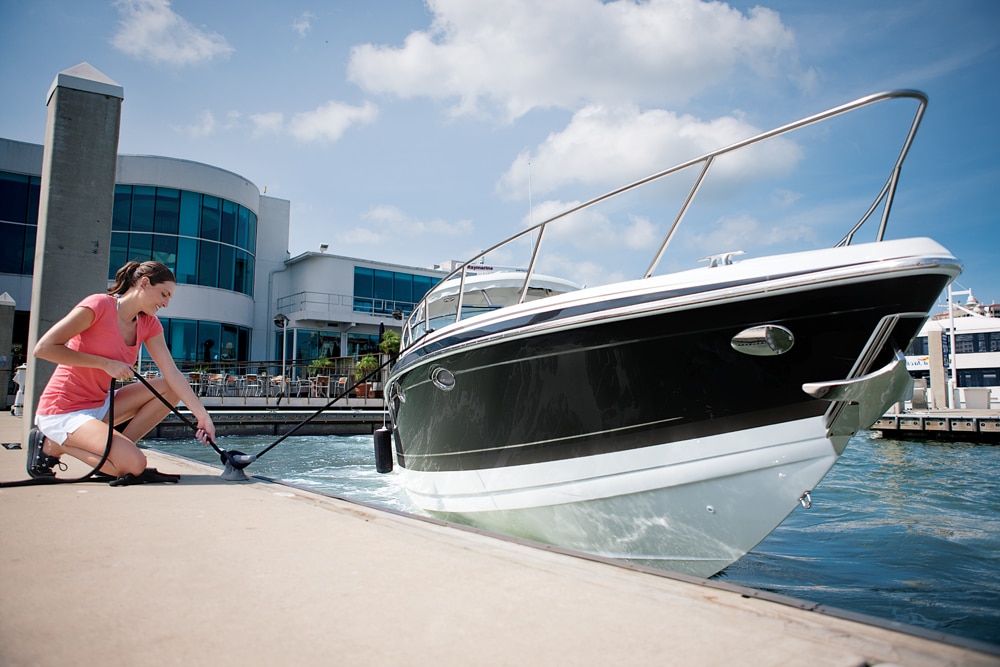
3. Dockmaster Docking Tip The first line to toss is your spring line, with loop fed through your boat’s cleat.
12 Tips From a Weekend Dockmaster
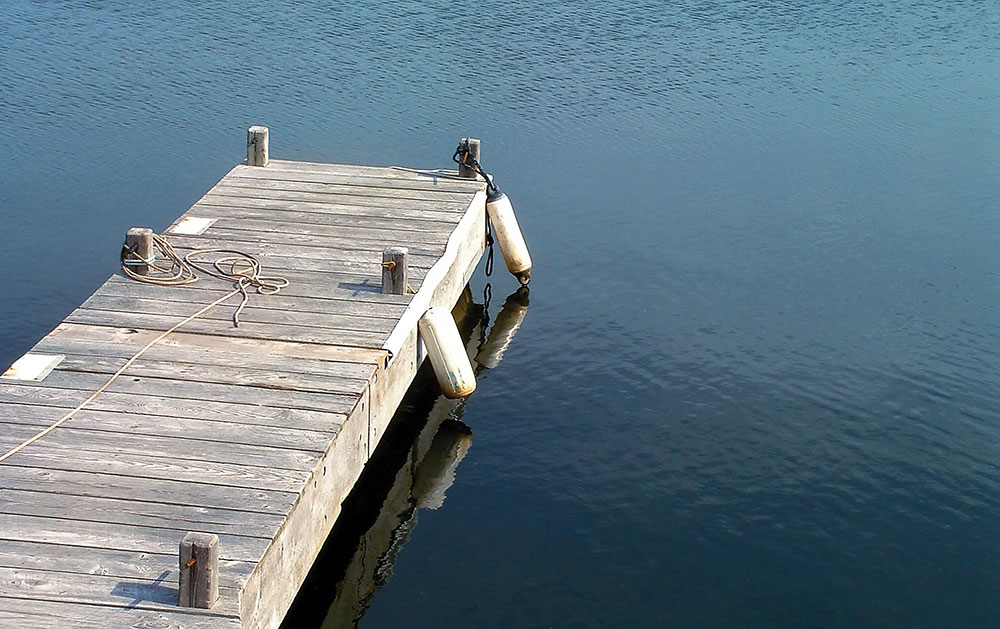
4. Warped Thinking Perfect the technique of “warping” to help you get out of tight docking situations.
Tips for Docking in the Wind
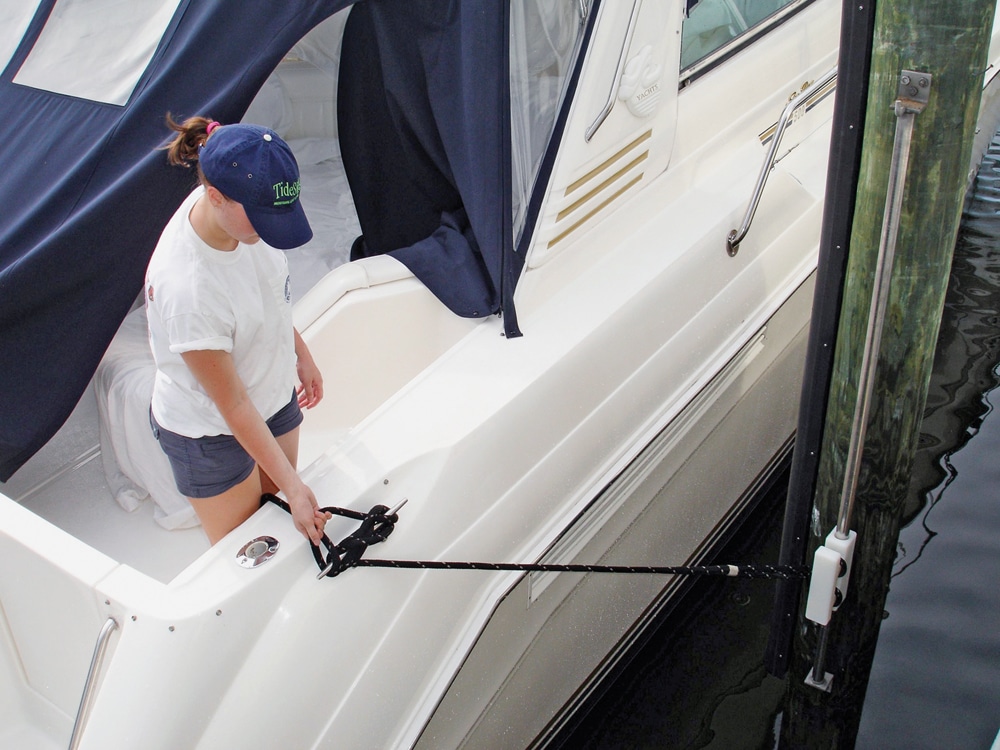
5. Leeward Lines First Remove the lines on the downward side first, since only the lines to weather are holding your boat in position.
Getting Out
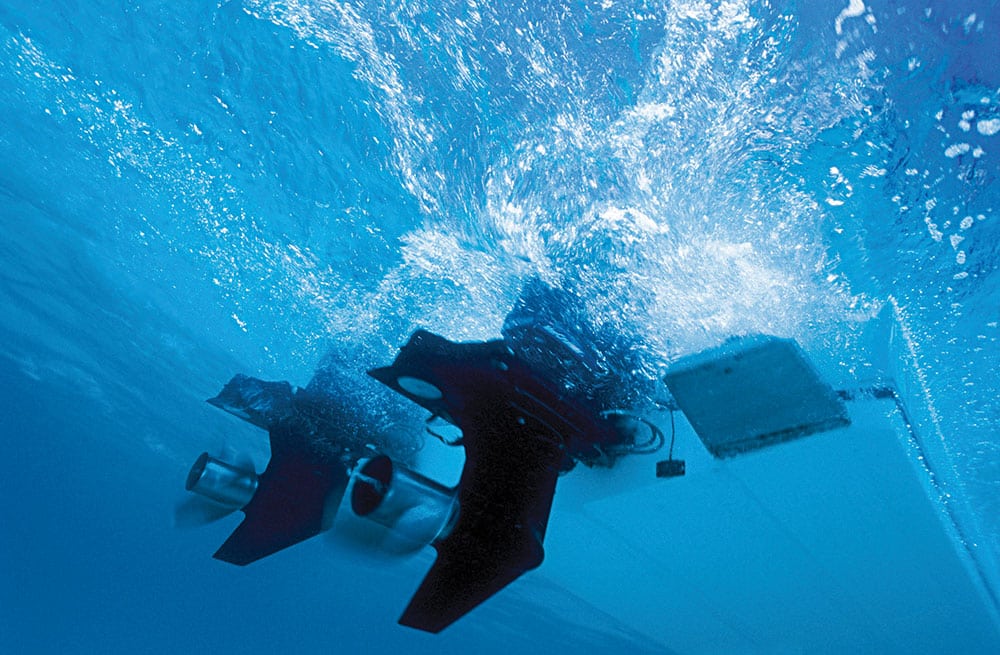
6. Using Reverse Learn how to make a reversing propeller your best friend and minimize stress and aggravation when docking.
Docking a Handicapped Twin-Screw
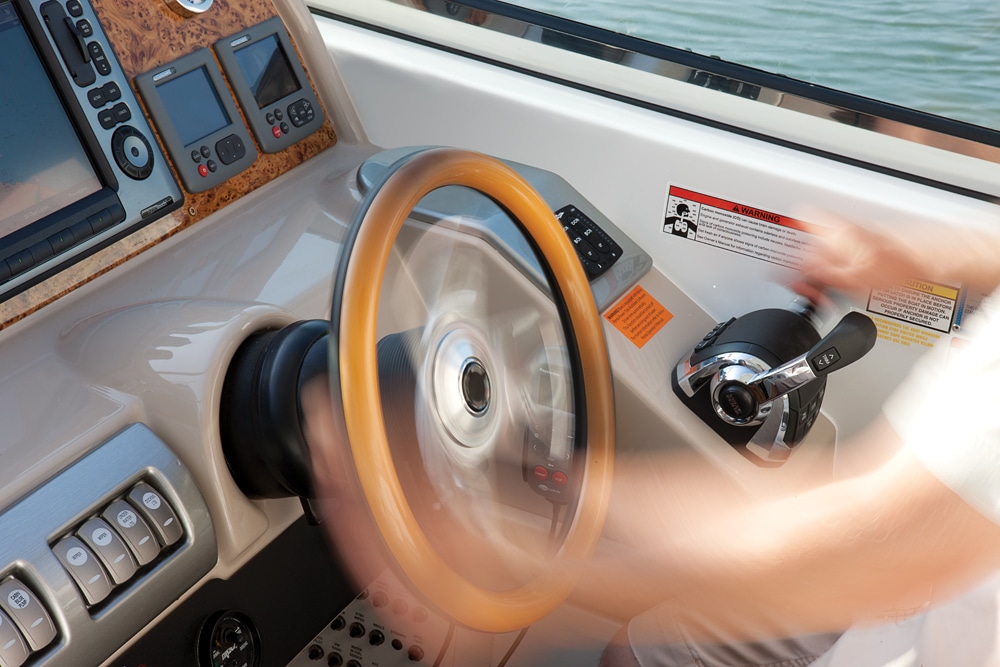
7. Watch Your Speed Minimal throttle, simply idling in gear, is the best speed for virtually every docking situation.
Dancing at the Dock
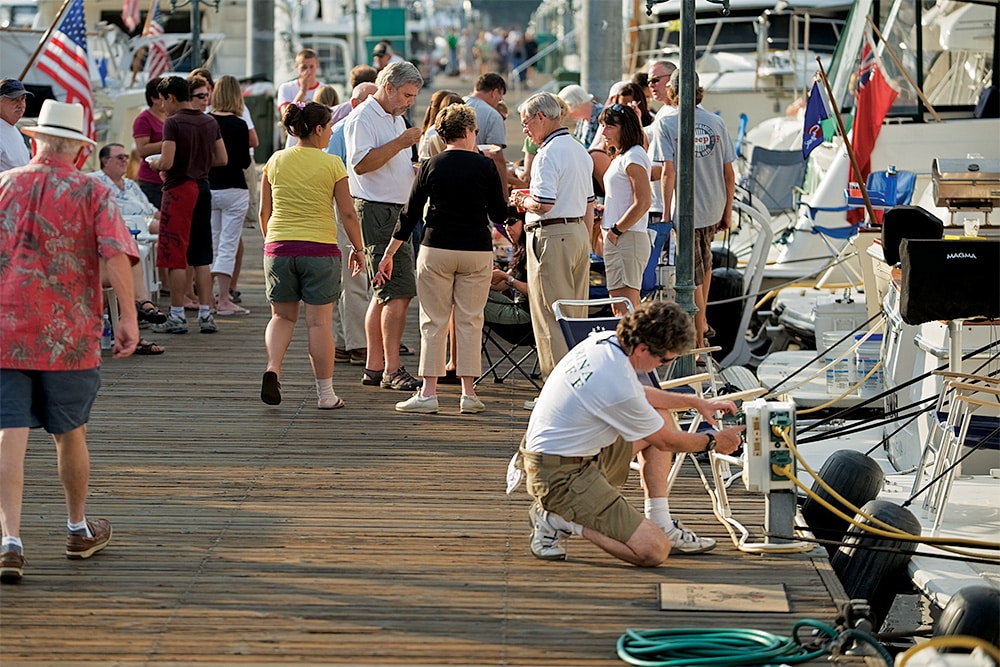
8. Stepping Up A dock hand will often step up onto a tied line, holding onto the boat for balance, and use the weight of her body to bring the boat in closer.
Doubling Up
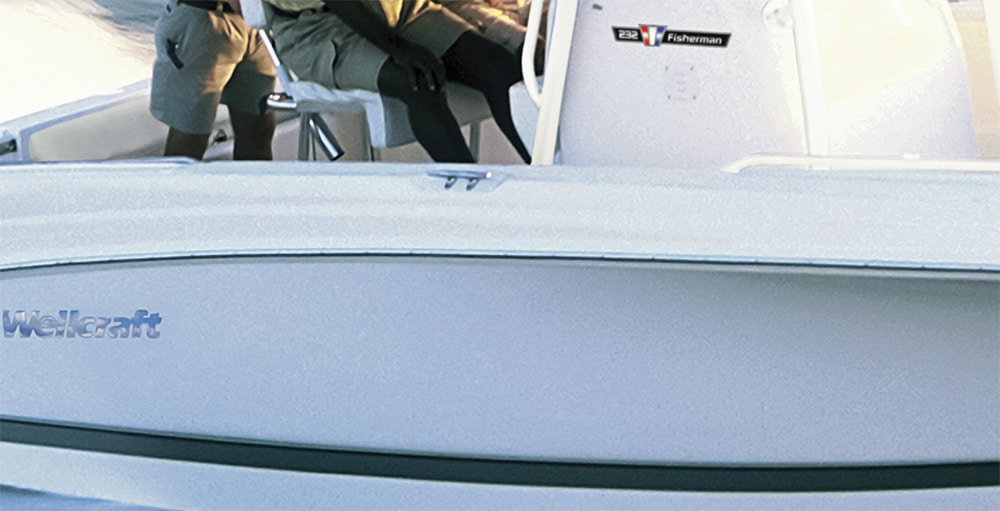
9. Controlled Docking The secret to “parallel parking” in a tight space is in knowing how to use the spring cleat properly.
Right Down the Middle
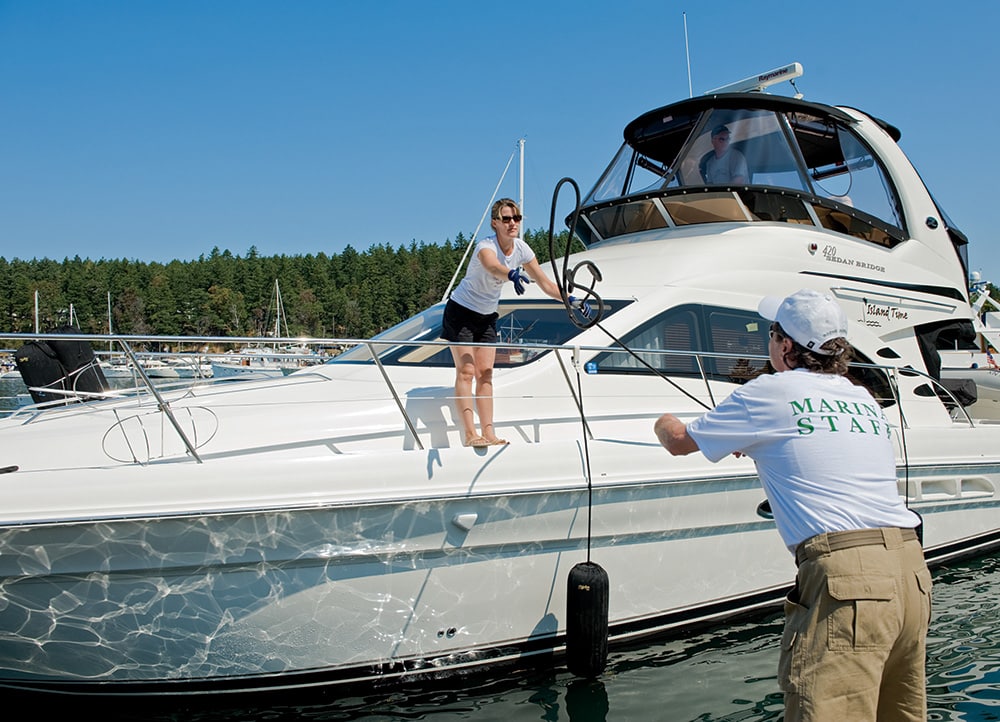
10. Toss a Line With a coil in each hand, step into a sidearm throwing motion, releasing when the coils are about shoulder high.
The Old Heave-Ho
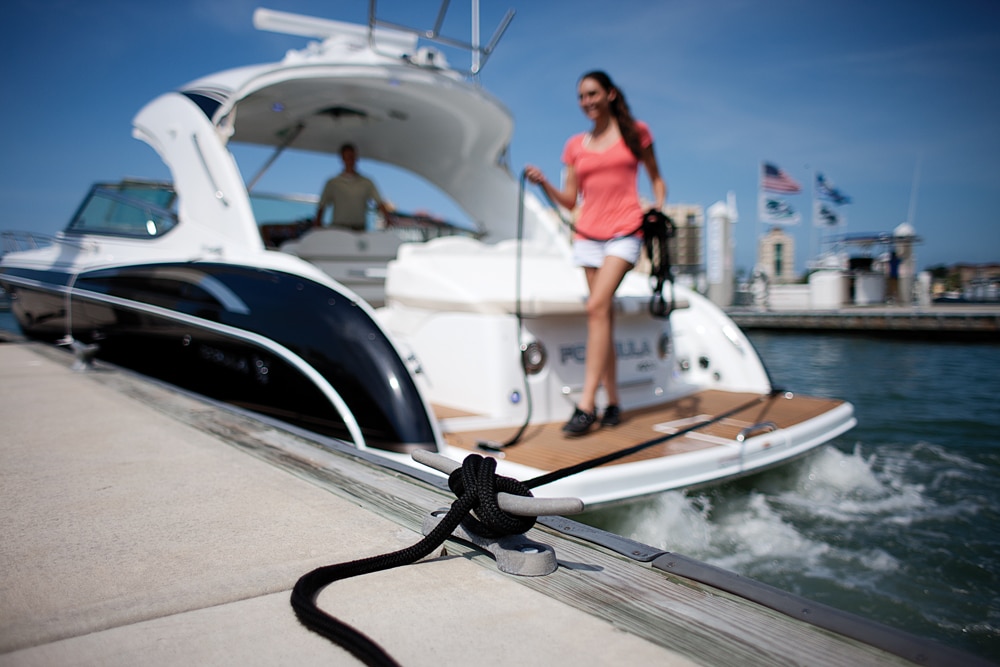
11. Hung Up Your boat can’t just be tied tight. You have to allow for the rise and fall of the water lest the boat be left hanging by its lines at low tide or pulled under by its lines at high tide.
Tips for Properly Rigging a Slip
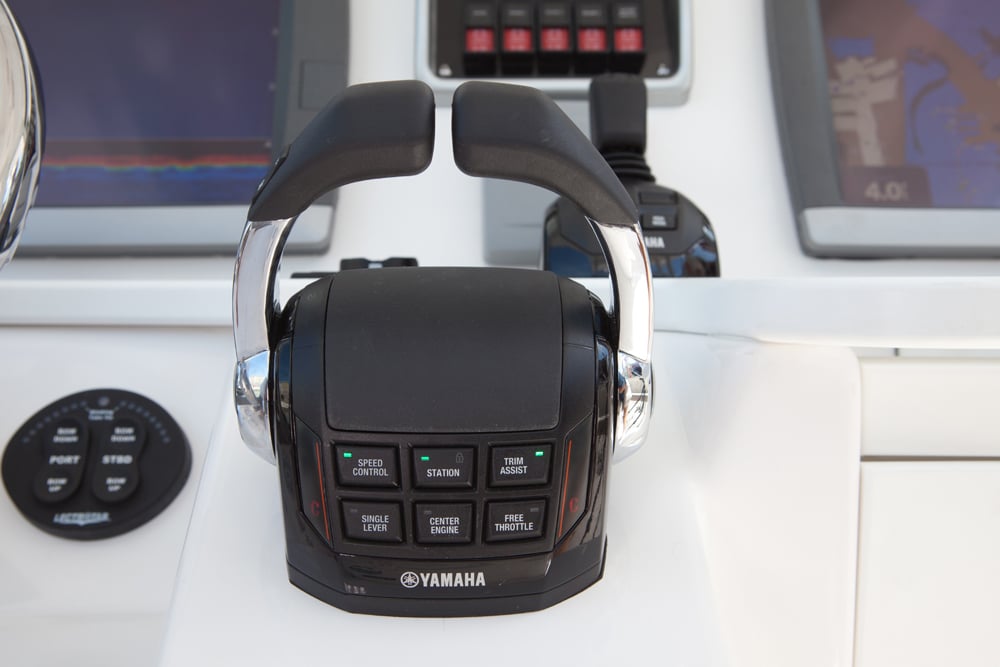
12. Make Small Steering and Throttle Corrections Use just enough throttle to move forward slowly, and if you need to shift to one side or the other, use small steering adjustments and wait for them to take effect before feeding in more.
Countercurrent
- More: docking , How-To , Photos
More How To

On Board With: Brian Grubb
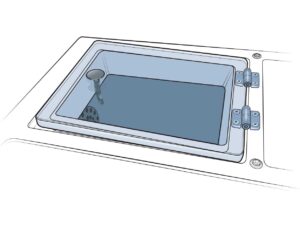
Installing Clear Acrylic Livewell Lids
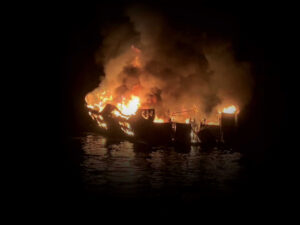
Captain of Dive Boat That Caught Fire Sentenced to Four Years
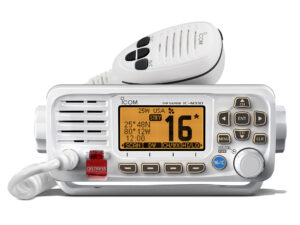
How to Make DSC Fully Functional on a VHF Radio
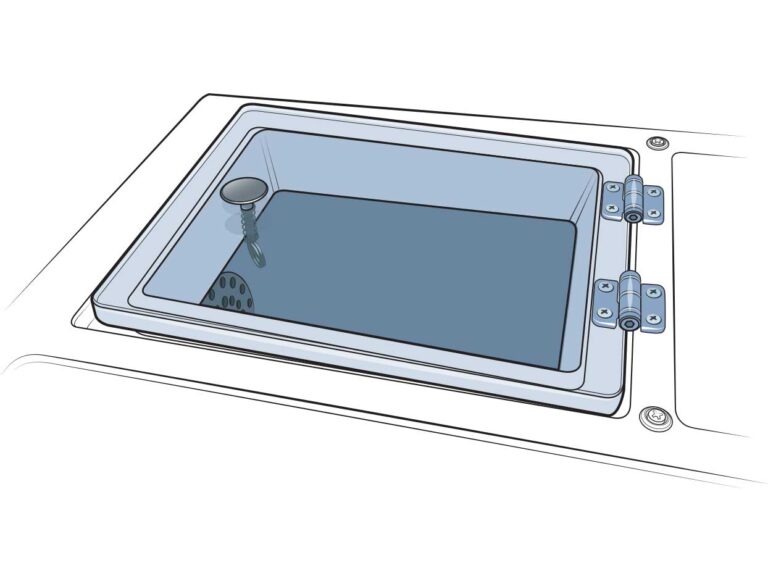
Boat Test: 2024 Solara S-250 DC
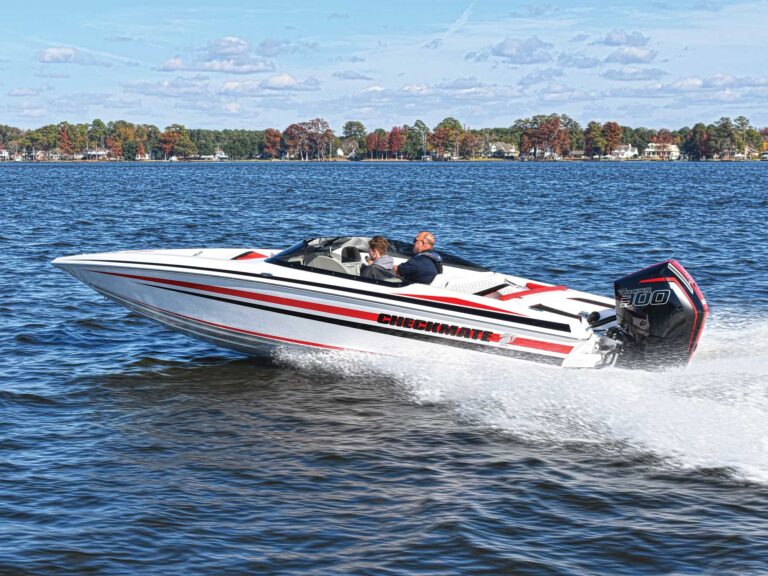
Boat Test: 2024 Checkmate Pulsare 2400 BRX
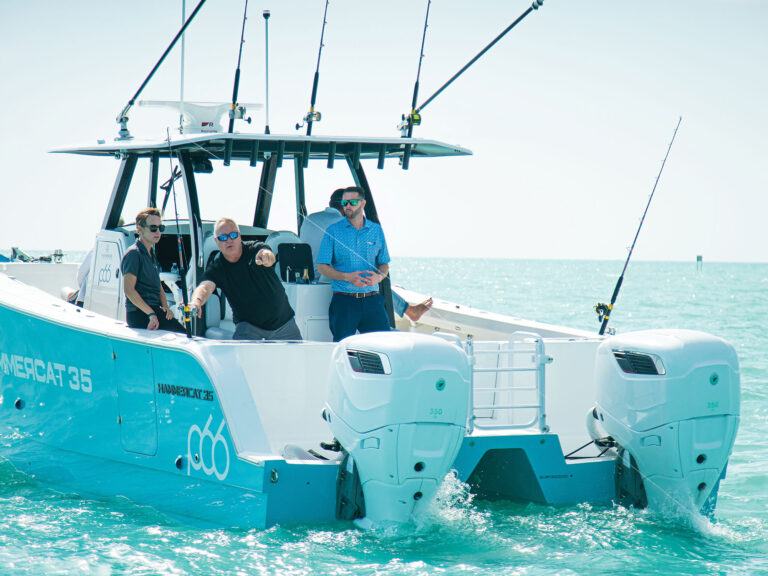
Cox 350 Diesel Outboard

- Digital Edition
- Customer Service
- Privacy Policy
- Cruising World
- Sailing World
- Salt Water Sportsman
- Sport Fishing
- Wakeboarding
Many products featured on this site were editorially chosen. Boating may receive financial compensation for products purchased through this site.
Copyright © 2024 Boating Firecrown . All rights reserved. Reproduction in whole or in part without permission is prohibited.
Docking a Boat: Step-by-Step Guide
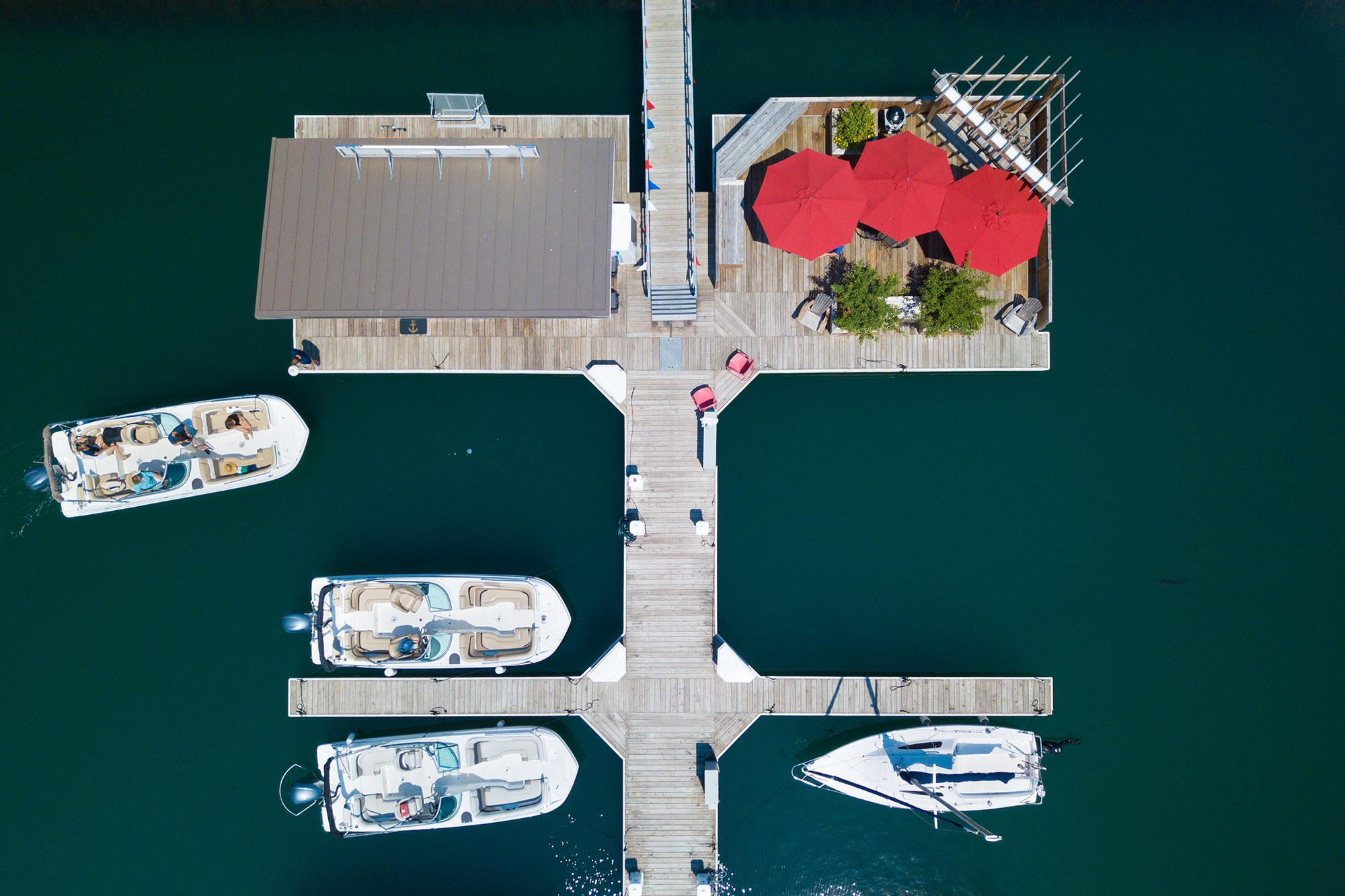
Docking a boat can often be intimidating and stressful, especially for those just getting started with boating. Luckily, learning how to dock a boat doesn’t have to be difficult, and boaters new and old can quickly master the task by following a few simple steps.
How to Dock a Boat
- Prepare dock lines on your bow and stern and attach fenders.
- Line up your approach and survey the docking area.
- Judge the current, wind, and water conditions.
- Take your time, proceed slowly towards the dock using intermittent acceleration.
- Never approach a dock any faster than you’re willing to hit it.
- Navigate into the boat slip or turn to come alongside the dock.
- Tie off your boat onto cleats, posts, or pilings using your docking lines.
It’s as easy as that! It can also be useful to have a friend or family member onboard or on the dock to help assist you throughout the process. If you’re docking by yourself, remember to take it slow and don’t be afraid to stop, pull back, and circle around to try again. Place your fenders ahead of time and have your docking lines ready to tie off as soon as you’re in close proximity to the dock.
Now, let’s get into some specifics about docking a boat in different situations.
Docking in a Slip
As a boater, docking in a slip is a common scenario you’ll often find yourself in regardless of whether you are docking in your own personal slip, a friend’s slip, or at a public marina or dockside restaurant. Before you begin, we highly recommend having your docking lines and fenders ready ahead of time on both sides of your boat. As in any and all docking situations, you’ll then want to start by checking your surroundings —look out for other nearby boats and be conscious of the conditions of the wind, water and current.
Next, always maneuver at a slow speed . Within a slip, you have limited mobility, which means you have little room to make mistakes. In most cases, you’ll want to position your boat so you’re able to back into the slip . Before you start backing in, you’ll want to center your wheel .
Slowly reverse your boat into the slip . Do your best to keep your balance and tell your passengers to stay seated during the process. This is not only for their safety, but it can help to keep the boat steady as it moves into the slip. Apply one last small burst of power forward to stop your reverse momentum . Then, tie off your lines to the dock. We suggest having two bow lines and two stern lines tied onto both sides of the slip—with the stern lines crossed.
Docking a Pontoon Boat
When it comes to docking a pontoon boat , there are a few factors to keep in mind that differ from docking other types of powerboats . While you’ll still want to concentrate on maneuvering at a slow speed, you’ll want to pay even closer attention to the wind and current conditions . The wind has the ability to completely push your pontoon off track during a docking situation—or worse, push it into the dock itself. If you have a strong breeze present, you can counteract this with small, controlled bursts of acceleration. Likewise, don’t be afraid to use reverse to stop any unwanted forward movement of your boat.
Particularly when first learning how to dock a pontoon boat, you may want to enlist as much help as possible and have someone on land guide your boat alongside the dock or into the slip. You can also be proactive by preparing your docking lines and fenders ahead of time .
Lastly, you’ll want to get to know your boat . For example, how much acceleration do you need to make a complete turn at a slow speed? How sharp can you take a turn? Just like cars, every boat is unique and the more you practice, the better you’ll get at overall handling and docking.
How to Tie a Boat to a Dock
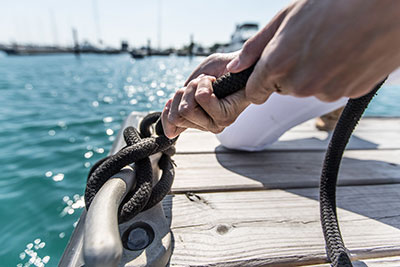
When it comes to docking equipment , you’ll want to keep a large supply of docking lines on hand. These docking lines, also known as mooring lines, can be used in a few different ways and can be referred to as bow, stern, spring and breast lines. In most cases, you’ll only be utilizing your bow lines and stern lines . The final piece of equipment you’ll want onboard are fenders, sometimes called “bumpers.”
When tying off your boat, you’ll usually be docking in a slip or alongside of a dock. In either of these cases, you’ll find cleats or pilings . Cleats are small, t-shaped equipment that are usually made of steel or some kind of metal that is attached to the dock. You also have similar cleats on your boat that you’ll use to attach your docking lines. Pilings, on the other hand, are large wooden posts that you would commonly find on a pier or positioned recurrently along the dock. Whenever possible, you’ll want to tie off your boat to the dock using cleats rather than pilings, for the simple reason that tying off on a piling can sometimes be more challenging.
When it finally comes time to tie your boat to the dock, there are a few common knots you can use to secure your lines: the cleat hitch , the clove hitch , and the bowline knot . Be sure to visit our Discover Boating YouTube channel to check out our videos on Boating Knots 101 .
Read Next: How to Tie Up a Boat
You Might Also Like:
- Anchoring a Boat: Step-by-Step Guide
- How to Navigate a Boat
- Boat Buyer's Guide
- Owning & Operating Resources
- Explore Different Boat Types

Join Our Newsletter!
Get community news, buying bargains, and how-to guides at your fingertips.

Your ability to dock well is the key to your reputation.
For many people docking their boat is one of the most trying experiences to be had on the water. Attempting to tie up to a busy fuel dock on a windy weekend day can test anyone's piloting skills.
Let's face it, you may be the greatest captain on the planet, but your ability to dock well is the key to your reputation.
The things you need to notice when you are about to dock is where you intend to tie up, where other boats are, what the wind is doing, and to a lesser extent what the current is doing.
- Look and see how much room you have to maneuver your vessel around the area you intend to dock.
- Docking next to a long open pier is usually going to be easier than backing into a narrow slip in a confined marina.
- Are other boats leaving or entering the area you need to turn? How other boats are tied up or moving can greatly alter your intended steering and docking.
- Knowing which way the wind is blowing can greatly aid your docking. When coming alongside a pier with the wind in your face, head in at a steep angle to the pier and turn sharply at the last moment to avoid being blown out by the wind. If the wind is at your stern, come into the dock at a narrow angle and let the wind do the work of pushing your boat up against the dock.
- Current can also effect your docking in a similar fashion to wind, and in some areas can preclude you from docking at all in low water. Consult your tide tables, especially when traveling in new waters.
At all times, maintain no more than steerage speeds and try and have some crew ready with lines to tie off immediately. Using your lines to assist in docking can save a great deal of time and energy. Lines can be used as simple fulcrums to help bring either end of your boat to the dock. Let the lines do the work.
Like the people who run them, all boats differ in their docking characteristics to one extent or another.
And, the distinctions are particularly significant among three separate types: single-screw, keel-equipped powerboats and sailboats; single-screw planing hulls of moderate draft powered by a single outboard or stern drive; and keel-less powerboats driven by twin engines, whether inboards, outboards, or stern drives.
Covering all three types (and the variations within each) would be impossible in one section, so we're going to restrict ourselves to single engines this time around.
If you are routinely experiencing frustration and anxiety when entering slips or tying up to docks, the very first step is to give yourself a break: handling a boat - any boat - in tight quarters is difficult, particularly if you've got an audience and especially if you have to deal with wind and/or current.
Sure, launch operators and charter boat skippers who make 500-1,000 landings a year are good at it, but why should you be? Your total is probably more like 50 dockings annually, and expecting yourself to be perfect is unrealistic.
So, as you're going into a docking situation, it's better to relax and admit to yourself that you're probably going to make a mistake. That step in itself should help you calm down and, more importantly, slow down. Only good can come of your being more deliberate and more forgiving of yourself and your crew.
Next to patience and self-control, your biggest ally in docking maneuvers is nylon line. If, early on in the process, you (or a crew member) can connect your boat to the targeted dock or piling, and if you then know what to do with the throttle and steering wheel, you've got it made.
Spring Lines
Here are some examples, all involving "spring" lines, a much-misunderstood term that simply means lines against which the boat can "work," thus ending up in the right position.
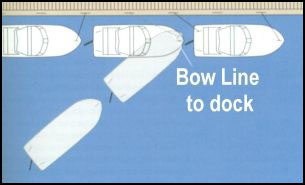
You are heading for a fuel dock consisting of a bulkhead of pilings and rip-rap. The problem is, you have to hit a gap between a 32' power cruiser and a 20' sailboat that are already tied up. And, to complicate matters, there's a 15-knot wind blowing directly off the shore.
The dock attendant is on hand and looking nervous because you aren't going to have more than 8' of clearance fore and aft. Don't worry! Ask one of your crew to throw him a line that is already cleated and coiled at the port rail forward, (preparation is 75% of the battle). As the dock attendant grabs the tag end of your line, ask him to attach it to a piling or cleat aft of the space into which you must fit.
Now, with the line secured at the dock and your wheel turned hard away from the dock (to starboard in this example), just put your boat in forward gear, at idle speed.
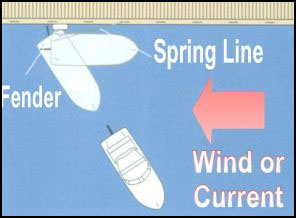
Miracle upon miracles, your boat will start moving sideways, into the allotted space! If you're working against current or wind and your progress is too slow, just advance the throttle slightly. You can also make small adjustments in your approach angle and speed by turning the wheel slowly one way or the other.
And, if it looks as if you're going to be too far forward of "the slot," momentarily shift into neutral, take up the slack that will immediately develop in the spring line, recleat the line again, and put the engine into reverse once more. If you're too close at the stern, carry out the same maneuver, but slack off the spring line.
Now, suppose there has been a 90 to 180 degree wind shift while you fueled up and went for groceries at the store down the block from the marina. When you get back to the boat, there's a 15-knot wind blowing directly down the dock.
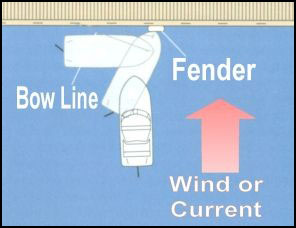
You can't go ahead or astern very far because of the boat behind you and the one ahead of you. How are you going to get out of this fix? Again, spring lines are the answer.
If circumstances favor your pulling out and moving ahead, run a long spring line from a cleat on your port rail astern to a piling or cleat on the fuel dock well forward of your position.
Let go your bow and stern lines. Now, with your wheel hard to port, put the engine in reverse and back the boat down. Like magic, your bow will swing out to starboard, clearing the boat ahead (you may need additional throttle if you're battling wind and current). You - perhaps aided by the dock attendant and/or a crew member-can now release the spring line and proceed out into the harbor.
When, on the other hand, circumstances favor your backing out of your spot, the spring line should be run from your bow to a piling or cleat well aft of your position.
In this case, let go the dock lines, turn the wheel hard to port (the side against the dock), put the idling engine into forward gear, and watch as your stern swings miraculously out of harm's way.
When it clears the boat behind you, momentarily shift into neutral, release the spring line (or ask that the dock attendant free it), shift into reverse, and back away smartly. Again, the peanut gallery will be very impressed.
Five Rules for Avoiding Injury
Before each docking maneuver, make sure everyone understands what he or she will be doing. The corollary to Rule 1 is that you should be aware of where your crew is and what each is doing.
A woman in California was securing a springline to a cleat when the skipper suddenly backed down hard with his two 200 HP engines and she got her fingers crushed. Another man was standing on the dock holding onto a trawler's bow pulpit when the skipper gunned the engine and yanked him into the water. In both instances (and many others) the skipper and crew were acting independently.
Don't encourage your crew to make Olympian leaps onto the dock. This is one of the most common types of accidents. A California man, to cite one example, broke both his heals when he landed on the dock after jumping from the bow of a large sailboat.
Whenever possible, hand docklines to someone on the dock. If that isn't possible, wait until the boat is safely alongside the pier before instructing someone to step ashore. Your crew shouldn't have to make daring leaps across open water to make up for your sloppy boat handling.
Keep fingers and limbs inboard! As a boats gets close to a dock, passengers tend to gravitate toward the rail and drape fingers, legs and arms over the side of the boat. If the boat suddenly swings into a dock or piling, the consequences can be painful.
A woman in lost a finger when a passing boat's wake slammed her boat into a piling, and pinched her hand between the piling and the boat.
Make sure everyone is seated or has something to hold onto. The owner of a 20' runabout asked his inexperienced nephew to jump onto the dock with a bowline. The young man eagerly climbed out of his seat and stood precariously on the bow as the boat was approaching the dock.
A few seconds later the boat glanced off of a piling, only slightly, but without a handhold the nephew lost his balance and fractured his elbow.
Don't use bodies to stop the boat. A Florida man suffered a separated shoulder when he tried to keep a 38' Sportfisherman from backing into a piling. Slow down and use fenders.

- Multihull Sailor
- Real Estate
- Maintenance & Hardware
- Water Sports
Docking, Anchoring, Mooring: What are the Differences?
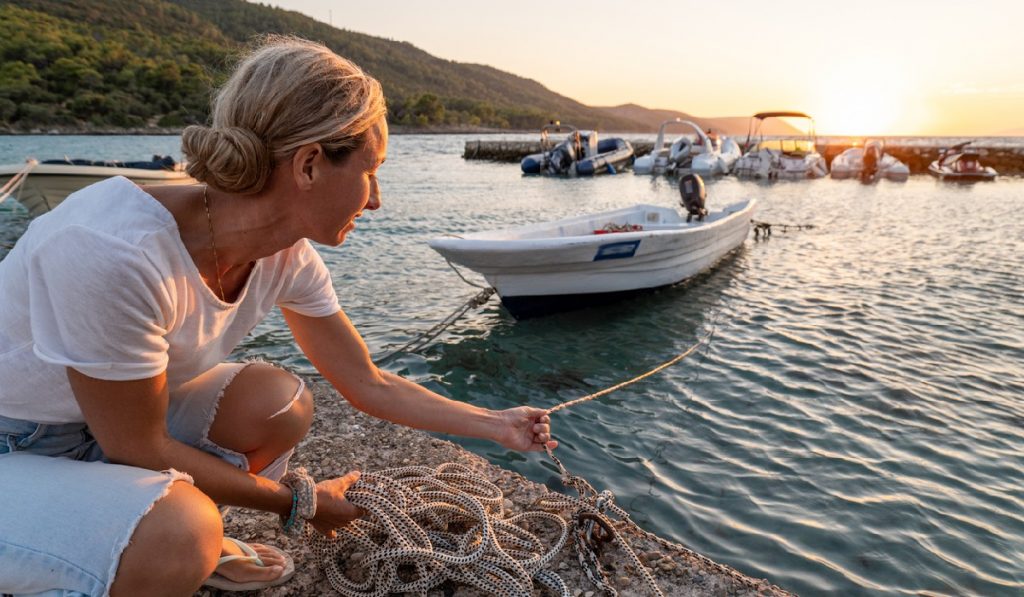
- 2 Anchoring
- 4 Notable Differences
- 5 When to Use Each Method
- 7 Anchoring
- 9 Conclusion
More from SAIL
Are you confused by the terms docking, anchoring , and mooring? Don’t worry, you’re not alone. There are multiple ways to secure your boat to a dock, anchorage, or mooring, and it can be hard to keep them all straight. In this article, we’ll discuss the differences between docking, anchoring, and mooring, so you can make a more informed decision about how to secure your boat the next time you set sail.
Whether you’re a novice boater or you have a couple trips at sea under your belt, this post should help you understand the basics of each method for securing a boat. We’ll discuss the advantages and disadvantages of each, as well as what type of boat each is best suited for. By the end, you should have a better understanding of the best option for your own boat.
What is docking? Docking is used when a vessel approaches a designated area in order to tie up or berth at a shore-side facility. This is usually done when supplies, fuel, and maintenance must be procured. When docking, boats are secured to cleats along the shore, pilings, or moorings using tow lines . This is typically done by using two fore-and-aft spring lines to keep the vessel away from the dock along with two bow lines and two stern lines.
Anchoring refers to when a vessel anchors itself to the seafloor with an anchor attached to the vessel by a rope or chain. Boaters typically use anchoring when they do not want to move around much, as well as when they want to be away from shore for an extended period of time. Depending on the size of the anchor and vessel, multiple anchors may be required in order to reduce potential dragging due to waves or wind shifts.
Mooring is similar to anchoring in that it provides an attachment point for vessels on the seafloor. However, with mooring, you will find permanent fixtures made from ropes, buoys, chains, and anchors set up in specific locations like harbors or marinas. Instead of dropping an anchor into the seafloor as you do with anchoring, these fixtures have already been set up by professionals and/or local governments making it easier for boaters to secure their vessels without having to worry about their anchors dragging due to shifting winds or currents.
Notable Differences
One of the major differences between docking, anchoring, and mooring is how long they can stay put. For example, while docking requires frequent departures and arrivals due to limited space availability (such as in marina harbors), anchoring allows for more flexibility in terms of length of stay – making it ideal for short overnight stays. On the other hand, mooring is most commonly used for longer stays, such as those that last weeks or months, since it involves setting up a more permanent fixture.
Furthermore, there are different types of vessels each method is suitable for – docking is mostly limited to larger vessels with deeper drafts (often two lines will be used to dock ships) while both anchoring and mooring can accommodate smaller vessels with shallow drafts. Lastly, while all three provide some degree of security there are differences in terms of how secure they can be – docking is more secure than either anchoring or mooring due to its closeness to shore.
When to Use Each Method
Now that we understand what the three different methods are, let’s discuss when it’s best for boaters to use each one:
Docking should be used when boaters need access to refill supplies (such as fuel), as well as repair services since these are typically only available from shore-side facilities like marinas/ This method should also be used if you’re looking for a secure spot for your boat due its proximity to land. Ultimately docking should be used any time boaters need easy access to shore and/or services that can only be found there.
Anchoring should be considered if you’re looking for a more open spot away from other vessels that are relatively safe. This method should also be used if you don’t plan on making frequent stops during your journey since it involves setting up an anchor which will require additional effort. Ultimately anchoring should be used whenever you need a place where you can stay put without having too many restrictions such as those found at docks or marinas.
Mooring should primarily be considered if you plan on spending an extended amount of time at sea – such as weeks or months – since it involves setting up a more permanent fixture. This method should also be used if you want easy access either through existing facilities (like harbors) or by having a boat operator come out every so often. Ultimately mooring should be chosen if you don’t want too much freedom but still need some level of freedom during your journey for supplies or repairs which can’t easily be found at sea.
So there you have it, a comprehensive look at the differences between docking, anchoring, and mooring. Whether you’re a beginner or a seasoned sailor, understanding these distinctions is essential for a safe and enjoyable boating experience. Whether you’re looking for a secure and convenient port, a peaceful spot away from land, or a more permanent spot for longer stays, the right security can make all the difference. Armed with this knowledge, now you can make an informed decision about the best option for your own boat. So, go out and explore the open waters in safety and confidence. Until next time, happy sailing!
Article Contributors
Sail magazine review team.
SAIL Magazine Review Team reports on best-selling products in sailing and boating. SAIL Magazine is reader-supported: When you buy through links on our site, we may earn an affiliate commission. Artificial Intelligence (large language models) may have been used in the research and creation of the content.
To ensure questions about product testing or a specific article are addressed, please contact [email protected]

The Boat Docker
A Power Boat Docking Simulator
The Boat Docker Training
The following articles provide all of the information you need to know in order to operate The Boat Docker simulator.
Welcome to The Boat Docker
This simulator is designed to train you to dock your twin engine or single I/O power boat before you actually try it in the water! To get started, click above on “Run Simulator.” Thanks for all the feedback! We are continuously updating the simulator to make it a more effective tool. Please email your questions or […]
New Dock configuration
From: from Deniz Tok: Hello there. I just found out about your sim and I loved it! I can’t stop playing. I have a Searay 450 EB with twin engines and separated shifts & throttles. This sim makes great sense and really helps understanding the physics of the boat. Maybe only the wind physics differ […]
GamePad Bug Fix
Thanks to Roy Lewis for pointing out that the GamePad Controller software produces blank simulator screens in some devices. So, we have added a new menu item to either enable or not enable the GamePad Controller. The default setting is Not Enabled.
Added Gamepad support directly in browser
Hello Everyone, I once again added Gamepad support. This works for both wired and wireless Gamepads. Here is the mapping: B Button – Move Left Stern ThrusterA Button – Move Right Stern ThrusterY Button – Move Left Bow ThrusterX Button – Move Right Bow ThrusterL Button – Left Throttle UpR Button – Right Throttle UpZL […]
Using a Game Controller with Mac OS
From user Pete Harris: Love the simulator ! It’s great for developing muscle memory, so you can just focus on strategy when things get real. It was a bit daunting trying to figure out what game controller to buy, coupled with the worry I was wasting my time, and would not be able to get […]
Inbox Suggestion from user John Torkelson I am in the process of buying a 35 to 45 foot boat and need to make a decision on “do I need side thrusters or not?”. Your simulator is great for helping me make that decision and I thank you for your effort. I do have two suggestions for you. […]
Updated Wind / Water Indicators
We updated the Wind and Water Indicators to improve the user experience. Just click on the + / – symbols to increase / decrease the wind / water speed. Then click on any circle to change the wind / water direction.
We have upgraded our URL to include a new SSL certificate. The new URL is https://theboatdocker.com ! Thanks.
This configuration was proposed by John who asked for a modification to the Man Overboard that would “Simulate backing down on a fish.” The fish moves quite a bit faster than the Man Overboard, otherwise it operates the same. Click on the water to move the fish.
Rudder Effectiveness and Single I/O Prop Walk
Thanks to your suggestions we have added Rudder Effectiveness and Single I/O Prop Walk. You can now select low/medium/high rudder effectiveness from the start menu. Be sure to refresh your browsers on the menu page and then again on the simulator page. For a single I/O with an engine speed of 600 RPM, the engine […]
- Today's news
- Reviews and deals
- Climate change
- 2024 election
- Fall allergies
- Health news
- Mental health
- Sexual health
- Family health
- So mini ways
- Unapologetically
- Buying guides
Entertainment
- How to Watch
- My watchlist
- Stock market
- Biden economy
- Personal finance
- Stocks: most active
- Stocks: gainers
- Stocks: losers
- Trending tickers
- World indices
- US Treasury bonds
- Top mutual funds
- Highest open interest
- Highest implied volatility
- Currency converter
- Basic materials
- Communication services
- Consumer cyclical
- Consumer defensive
- Financial services
- Industrials
- Real estate
- Mutual funds
- Credit cards
- Balance transfer cards
- Cash back cards
- Rewards cards
- Travel cards
- Online checking
- High-yield savings
- Money market
- Home equity loan
- Personal loans
- Student loans
- Options pit
- Fantasy football
- Pro Pick 'Em
- College Pick 'Em
- Fantasy baseball
- Fantasy hockey
- Fantasy basketball
- Download the app
- Daily fantasy
- Scores and schedules
- GameChannel
- World Baseball Classic
- Premier League
- CONCACAF League
- Champions League
- Motorsports
- Horse racing
- Newsletters
New on Yahoo
- Privacy Dashboard
Billionaire fights to dock his boat on water behind his house. His 164-foot boat, that is.
For some people, the ultimate Florida lifestyle is a waterfront house , a private dock and a boat parked next to it. But what if that boat is a mega-yacht , and the mega-yacht stretches 164 feet?
That's the conundrum facing the Village of North Palm Beach.
This tiny community in northern Palm Beach County, with only 13,000 full-time residents, has an identity so tied to the water that a ship's steering wheel is the village's emblem.
But it's that love of the water that is putting one resident at odds with village leaders.
For the past several years, homeowner Michael Bozutto has been battling the village for the right to park his 164-foot Westport, dubbed Honey, behind a home he owns at 932 Shore Drive.
The house, built in 1961, is a one-story, ranch-style property with three bedrooms on a half-acre lot. Bozzuto paid $840,247 for the house in 2014, according to Palm Beach County property records.
Lawsuit rooted in dispute over where to dock mega-yacht
What makes this plain house special is its location. It's on a rare corner bordered on the north and east by navigable waters that provide access to the Atlantic Ocean via the Lake Worth Inlet. The east-facing dock is large enough to accommodate Bozzuto's motor yacht.
Since Bozutto bought Honey for an undisclosed sum a decade ago, he mostly has parked it at the Old Port Cove Marina, near Tiger Woods' 155-foot showy mega-yacht, ironically dubbed Privacy.
More recently, Bozzuto has wanted to park Honey alongside his Shore Drive house, one of four houses he owns in the village. While Bozzuto keeps some personal property at the Shore Drive house, he lives at a house he owns at Harbour Isles Court.
Village officials warned Bozzuto he can't park Honey at 932 Shore Drive because boats can only be parked on docks behind houses that are occupied by the homeowner.
But village rules do not define the word "occupied." For instance, the rules do not state that occupied means the house is a residence where the owner lives. Village rules also contain no restrictions on the size of boats that can be kept at private docks.
After years of pushing back against what he believes are fuzzy rules, Bozzuto in March filed a lawsuit against the village.
More: Cannonsport Marina sells for $58.5 million in big deal for tiny Palm Beach Shores
He alleged the municipality is illegally depriving him of his property rights because nothing in the village code prevents him from mooring Honey at his house. He is asking a Palm Beach County Circuit Court judge to rule that he has a constitutional right to dock Honey there.
Gregory Coleman, Bozzuto's West Palm Beach attorney, said the village has plenty of waterfront homes with yachts parked behind them. But Coleman said the village is illegally blocking Bozzuto from docking Honey at his house because the village is bending to pressure from a handful of neighbors who think the boat is too big.
The selective enforcement is wrong, said Coleman, a former president of the Florida Bar.
"He's a very under-the-radar guy who doesn't cause anybody any problems," Coleman said of Bozzuto. "He pays his property taxes, and he wants to be left alone by the village of North Palm Beach. Unfortunately, they are singling Mike out."
Neither Leonard Rubin, the village's longtime attorney, nor Village Manager Chuck Huff responded to requests for comment.
Eric Stettin, a Fort Lauderdale-based attorney who is representing the village in the Bozzuto lawsuit, said he could not comment on pending litigation.
What good is a man's castle if he can't have a boat in his moat?
Coleman's lawsuit describes the conflict as a battle over property rights, but real estate and yachting experts say it's also a sign of the times.
As wealthy new residents pour into the county wanting all the perks of the Sunshine State, they want a boat to go along with their waterfront homes and golf club memberships. Some longtime residents fear Palm Beach County is turning into a playground for billionaires, to the detriment of everyday people who also want to live in sunshine and peace.
This conflict between Old Florida and new money is an ever-present tension, but even seasoned yacht brokers say they've never seen interest in luxury yachts quite as strong as it is now.
More: Illegal boat slips are popping near Palm Beach Gardens. Residents want regulators to act
"What we've seen in the marketplace right after COVID in the yachting industry, and especially the superyacht segment, is the most incredible growth ever seen in the history of yachting to date," said Shannon McCoy, a luxury yacht advisor and broker with Worth Avenue Yachts in Palm Beach.
"A lot of people are moving here with serious money," added Pascal Savoy, U.S. managing director of Camper & Nicholsons International yacht brokers in Fort Lauderdale.
While in the past Palm Beach County was not considered lively enough for some buyers, Savoy said the county's growing sophistication is putting it on the map in a way never seen before.
"It's a mini-Monaco for us," Savoy said.
Prices for mega-yachts can range from $18 million to $60 million, or many times that, for the largest and most decked-out mega-yachts, Savoy said.
While some yachts can be glitzy, a 164-foot Westport is considered a more low-profile boat, Savoy added.
Michael Bozzuto's interests: Houses, boats and philanthropy
Bozzuto is no newcomer to North Palm Beach. He's been a resident of the village for 20 years.
He is the billionaire owner of a family-owned supermarket wholesaler in Connecticut, and an investor and philanthropist who likes to collect houses and yachts, Coleman said.
In addition to the four North Palm Beach houses and several yachts he owns, Bozzuto in February paid a whopping $31.1 million for a house in the Town of Palm Beach Shores. The house, which has two docks, sits just north of the Palm Beach/Lake Worth Inlet.
Twin City Mall: North Palm clears way for redevelopment, taller buildings at landmark site
Coleman said there is plenty of room for other boaters to navigate the waterway when Honey is parked at the Shore Drive house in North Palm Beach. And while other people may not have as large a yacht, there are other sizeable yachts parked on docks behind other North Palm Beach homes, too, he added.
At a 2017 village council meeting, then-Mayor Darryl Aubrey commented on the issue, according to the complaint.
"When I didn't live here full time, I had a boat sitting in my dock, I was gone nine months of the year. I don't see how you can say that someone has to be in a residence year-round, seems to be some interpretation of occupant, there would be an enormous number of violations," Aubrey said.
Another member of the village council asked if the village had a definition now, the complaint said.
Rubin, the village attorney, replied: "No, we don't," according to the lawsuit.
Show me the money? Here it is: West Palm and Palm Beach rank in top 5 as cities with fastest growth in millionaires
Palm Beach County's waterways run deep, and they are popular
The yacht docking dispute is particularly timely, given the scarcity of dock space for boats of all sizes.
The most convenient place to park a boat is on the water behind a house, brokers say. But not every waterway or channel can accommodate the draft, or depth, of a mega-yacht.
However, the dock behind Bozzuto's Shore Drive house can.
Not only is the Westport not known for its deep hulls, but the waterway also is typical of northern Palm Beach County, which boasts deep water and easy access to the ocean via the Lake Worth Inlet, said Coleman, a lifelong boater.
"In Palm Beach County, they have deeper water, and it allows people to have larger yachts," Savoy agreed.
But not every waterway is deep enough for every boat.
McCoy said she specializes in helping advise potential yacht owners about the county's varied water depths before they buy a house, if they plan to dock their yacht behind it.
If yacht owners don't have a private dock, the other option is a marina. But marina space is hard to find, with many dock berths reserved for months in advance, McCoy said.
Despite the challenges of owning a boat and finding a place to dock it, yacht brokers say demand continues.
They see interest continuing from business executives moving here with their families as they relocate their companies to Palm Beach County. There's also a growing demand for yachts among female buyers, McCoy added.
They also see younger mega-yacht buyers, some even in their early 30s. This is in sharp contrast to the mostly older buyers in the past, Savoy said.
Palm Beach County may not be as go-go as Miami-Dade County when it comes to showy ships, but if interest continues, "it's coming," Savoy said. "You're going to attract bigger yachts."
Put another way: "No one needs a boat, but everyone needs a boat," McCoy said. "It's the ultimate lifestyle."
Alexandra Clough is a business writer and columnist at The Palm Beach Post . You can reach her at [email protected] . Twitter: @acloughpbp . Help support our journalism. Subscribe today.
This article originally appeared on Palm Beach Post: Mega-yacht owner fights to dock boat behind North Palm Beach home
Recommended Stories
Roomba robot vacuums are up to $425 off for memorial day.
Wellbots has the iRobot Roomba Combo J9+, Engadget’s favorite vacuum-mop combo, for $425 off. The machine not only cleans floors and carpets; its redesigned dock can automatically empty debris and refill it with mopping liquid.
Alyssa Milano says Nioxin 'helped tremendously' with hair loss — snag their products on sale for Memorial Day
The actor credits this thickening system with restoring her lovely locks.
Amazon's No. 1 bestselling mascara is so popular, a tube sells every few seconds — and it's only $5
'I really do look like I have on falsies': Over 249,000 five-star fans say you'll get length, volume and zero clumps.
Gordon Ramsay calls HexClad 'the Rolls-Royce of pans' — score up to 45% off nonstick cookware for Memorial Day
These sets feature the best traits of stainless steel, cast iron and nonstick — and some bundles include extra freebies!
'My skin is more glowy': This No. 1 bestselling anti-aging serum is nearly 40% off at Amazon for Memorial Day
Grab it while it's just $19 — more than 94,000 shoppers are hooked, saying it helps reveal brighter, more radiant skin.
I review tech for a living, and these are the 45+ best Memorial Day deals on Apple, Sony, Samsung and more
Some noteworthy wins: 40% off Apple AirPods, 50% off a Samsung 55-inch Smart TV and $100 off Beats Studio Pro headphones.
Spyware app pcTattletale was hacked and its website defaced
U.S.-made consumer-grade spyware app pcTattletale has been hacked and its internal data published to its own website, according to a hacker who claimed responsibility for the breach. TechCrunch is not linking to the site given the ongoing risk to victims, whose private data has already been compromised by the spyware. The hack comes several days after a security researcher said he found and reported a vulnerability in the spyware app itself, which leaks the screenshots of the devices it was planted on.
'Sharper than the DeWalt ': This six-inch, one-handed chain saw is just $39 — that's 50% off
This lightweight beast is destined to be the sleeper hit of your power tool stash.
Homeowners hit pause on remodels as costs get 'just ridiculous'
Two of the nation’s top home improvement retailers reported this month that consumers are spending less on big-ticket projects.
WWE King and Queen of the Ring 2024: Live updates, results, matches, grades and analysis as WWE heads to Saudi Arabia
WWE King and Queen of the Ring takes place this Saturday in Saudi Arabia. Saturday marks the 23rd time in WWE history that a King of the Ring winner will be crowned and just the 2nd time ever a Queen of the Ring will be honored.
Famous Fort Myers Beach boat, left stuck on dock after Hurricane Ian, now a work of art

Famous Fort Myers Beach boat, left stuck on dock after Hurricane Ian, now a work of art

It wasn't enough for visitors to Fort Myers Beach, and in particular Bonita Bill's Waterfront Cafe, to have a photo taken standing next to the giant boat called the Batchelor Pad .
What started as an awesome photo opportunity has turned into an art project, you could say.
For several months now, people coming to Bonita Bill's for a bite to eat or a cold beverage, have been signing their names and writing messages on the boat's hull. The graffiti has added to the legend of the 42-foot, 20-ton (40,000 pounds) Bertram Yacht that was impaled on a couple of dock posts during Hurricane Ian . The boat has remained in exactly the same place since Sept. 28, 2022.
More: USA TODAY readers picked Florida location as a 'Best Hiking Trail' in America. It's in SWFL
Photo gallery: How a boat's hull has turned into a work of art
Along with the writing, there are stickers and even a business card has been strategically placed on the hull. It's long past looking like something you'd see in an art gallery, but with additional name or message, it keeps getting better and better.
Time is running out, though − for a selfie or to scribble a message. Bonita Bill's owners are committed to having the boat removed for safety concerns, and also the fact that a valuable space used for the restaurant − where customers who come to the restaurant by boat dock their vessels − is being occupied by Batchelor Pad .
- Video shows 78-year-old boater docking boat alone after crash that killed 15-year-old girl
CORAL GABLES, FLA. (WSVN) - New video shows the moment an elderly boater arrived to his Coral Gables dock after a boating accident that left a 15-year-old girl dead.
The video, shared by the attorneys of Carlos Alonso, shows Alonso, 78, departing alone on Saturday afternoon and arriving back, an hour later, to his dock. Upon his arrival, he begins tying the boat to the dock.
“He’s not going to make a statement at this time, other than to say he’s absolutely devastated about the tragedy,” said his attorney, Lauren Krasnoff.
Alonso’s attorneys made the case that the new video bolsters their contention that their client, who goes by the name Bill, had no idea he may have hit and killed the teen, later identified as Ella Adler.
In a new statement shared Friday, the attorney said:
This was an unthinkable tragedy and our hearts break for Ella and her family. We hope this video helps to shut down some of the awful and unfounded rumors going around about Bill, who is absolutely devastated. As the video shows, Bill was alone. He was not drinking. And he had no clue that he may have hit someone – he parked the boat at his home, he was calm, he didn’t clean the boat, and he did not try to hide anything. Bill will continue to cooperate with law enforcement in every possible way. Lauren Krasnoff
Adler’s tragic death occurred last Saturday in Biscayne Bay near Key Biscayne. Investigators said the victim has finished wakeboarding and had fallen into the water.
Investigators said she was then hit by a boat.
Witness accounts led investigators to the boat parked outside Alonso’s home in Coral Gables.
Florida Fish and Wildlife Commission officials confiscated the boat on Tuesday.
On Wednesday, investigators revealed the owner of the home where the vessel was docked was also the person who was driving it on Saturday.
In an interview earlier this week, Krasnoff made clear that alcohol was not involved in this incident.
“He was out on the water alone that day. He had no idea that an accident had occurred. He does not drink, and he was not drinking on that Saturday. He had no knowledge of the accident until law enforcement came knocking at his door,” she said.
Alonso declined to speak to 7News this week. FWC said he is cooperating with their investigation.
Copyright 2024 Sunbeam Television Corp. All rights reserved. This material may not be published, broadcast, rewritten or redistributed.
- Man injures nephews, 15 and 21, before fatally shooting himself in Hollywood
- ‘He had no idea that an accident had occurred’: Attorney for boater in fatal accident speaks out, expresses devastation
- Woman arrested after attacking men with screwdriver following MacArthur Causeway crash
- Miami-Dade tag agency clerk arrested in connection with $3M title fraud scheme

UW dock renovations pose threat to 75-year sailing tradition, yacht club students say
S tudents in the Washington Yacht Club (WYC) accuse the University of Washington (UW) of working to stop a 75-year history of teaching students to sail.
Those students told KOMO News that the UW’s plans to renovate the docks near Husky Stadium will eliminate the docks they use to store their 70 boats, thus taking away their ability to teach students to sail.
“It would really mean, like a death blow to the community,” said Renee Chien, the current Rear Commodore of WYC.
The U.W. has plans to repair and remove docks. The total dock space will be reduced by 4,000 square feet.
“And the university has actually given us a statement as of March that we will no longer be able to keep beyond one boat on the dock,” said Chien.
UW told KOMO News that the club only needs to move some of the club's boats short term.
“We have up to 75 boats. We’ve got everything from sailboats up to a 44-foot ocean-going vessel and everything in between,” said William Rae, another member of WYC.
Once the renovation is completed in 2025, the university told KOMO that UW recreation will no longer maintain dock storage space, so the WYC and the Union Bay Rowing Club would each be able to maintain just one boat at the dock.
“It would mean the loss of something that I have poured my heart and soul into,” said Chien. “And I feel like that is the case for most people that I work with in the WYC, who like are united by their common love of sailing.”
Chien told KOMO she just joined the WYC in November, to learn to sail and loves it so much, she’s already been out sailing 22 of the past 23 days.
“I grew up in Taipei, Taiwan and as an international student, I wouldn’t have felt like my roots were planted firmly anywhere. I thought maybe I would stay in Seattle maybe I wouldn’t, but I didn’t feel attached and it was really because of sailing and because of my access to the water and this newfound connection that I have with the Puget Sound that I feel like I would like to stay here to keep sailing and keep building the community here,” explained Chien.
Perhaps the best part of getting out on one of the 70 boats to learn to sail, is the price. Students pay just $39 per quarter.
“And if we lose that that’s a huge loss to people being able to enter into a sport that traditionally has such a high barrier,” said Rae.
Sailing lessons in Seattle cost several hundred dollars a month.
“We’re pretty unique, definitely in the Pacific Northwest, and really for student-run organizations we believe we're unique in the country,” said Rae.
UW's tradition of sailgating right outside Husky Stadium is another unique Pacific Northwest tradition and some accuse the University of putting profits from events like this over student benefit.
The renovation plan calls for adding new docks for large sailgating boats plus greater access for students and the public to rent kayaks and canoes.
“And we just want to emphasize that kayak rentals are $19 per hour our quarterly membership is $39 a quarter,” said Chien.
UW told KOMO that they are prioritizing Rec Clubs with the new waterfront plan, to expand student participation.
Construction on the docks and beach at the UW is scheduled to start in January and UW told KOMO that they are still working with the WYC through this process.
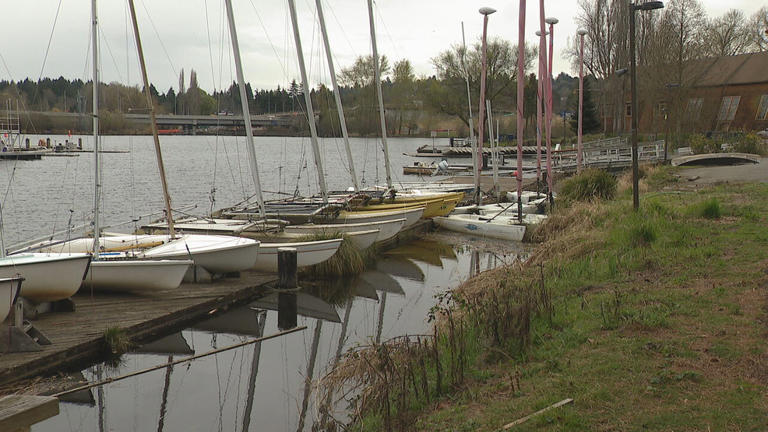

What are the best free Boat Games online?
- Battleships Armada
- Hydro Storm 2
- Battleship War
- Raft Wars Multiplayer
- Raft Wars 2
What are the most popular Boat Games for the mobile phone or tablet?

IMAGES
VIDEO
COMMENTS
Preparing for Docking. Preparing for docking is a crucial aspect of successfully maneuvering a sailboat. As we delve into this section, we'll discover the key steps involved in ensuring a smooth docking process. From reducing sail area to securing loose items and assigning roles and responsibilities, we'll explore the essential preparations that will help you navigate the docking procedure ...
This is our introductory video to a series on docking a sailboat. This video introduces a set of processes which will allow you to dock your boat with grace...
Follow our beginner's guide on how to dock a boat, 6 Steps to Docking a Boat Like a Pro, powered by Progressive®, to discover a few simple ways to feel more ...
Double up on the bow line and double back on the forward spring line by running each of these lines from a bow cleat and stern cleat, around a piling on the dock, and back to the cleat again. Put the engine in reverse and bow will pivot out. Make sure you have someone with a roving fender at the stern to protect against hitting the dock.
Learn how to dock a sailboat under sail, or under power, in a variety of different scenarios. Sailing legend Peter Isler walks us through the process using animations, illustrations and live action footage. Understand the techniques and skills required by both skipper and crew in order to make your docking experiences safe and easy.
Utilize Spring Lines. Spring lines play a crucial role in docking, helping to control the boat's movement and prevent it from drifting away. Secure a spring line to a cleat on the dock before bringing the boat alongside. This line will act as a pivot point, allowing you to control the boat's position more effectively.
Docking can be incredibly challenging and result in lots of damage to your boat, to other boats and to docks. Watch the video to see some simple tips to do t...
When docking, you'll want to have all lines prepared, have a plan for your approach to the dock, assess the current and wind direction and speed, proceed slowly, and let the wind and water do most of the work. You can gently correct as you go. When alongside the dock, secure the boat properly. That's docking from a 30,000' view, but there ...
Tradewinds trains you to stay on the boat, keep the boat under control, and step off the boat to tie dock lines only when the excitement has ended, the boat is stopped, and it is safe to do so slowly. Motoring Concepts. Moving a boat under power has six elements that you have to balance or learn to work around. Wind and Current clearly can ...
Prepare the boat. Docking with wind or current. Approach the dock slowly. Swing the wheel. Rent, Charter, Share— Only at Boatsetter. 1. Make a plan. If you are unfamiliar with the dock, make a reconnaissance pass to determine how you'll approach it. Things to consider as you prepare to dock the boat:
12 Top Docking Tips 12 Top Docking Tips Boating Magazine. 2. Learn How to Use Wind and Current to Your Advantage When docking in a tough spot, wind and current — coupled with knowledge of how they affect your boat — plus situational awareness can serve you better than an army of deck hands.
Understanding the basics of boat docking is the first step towards gaining confidence in this skill. The Importance of Mastering Boat Docking. Mastering the art of boat docking is essential for several reasons. It ensures the safety of your boat, prevents damage to the dock or other vessels, and most importantly, keeps everyone on board and ...
How to Dock a Boat. Prepare dock lines on your bow and stern and attach fenders. Line up your approach and survey the docking area. Judge the current, wind, and water conditions. Take your time, proceed slowly towards the dock using intermittent acceleration. Never approach a dock any faster than you're willing to hit it.
Tangle a mooring line in your propeller, and that docking job will go south in a hurry. #4: With twin inboards, don't touch the wheel. Ever. You'll be tempted, but you have more control if you leave the wheel centered and use only the engines. If you do turn the wheel, then when you try to use the engines and the prop-wash hits a cockeyed ...
When coming alongside a pier with the wind in your face, head in at a steep angle to the pier and turn sharply at the last moment to avoid being blown out by the wind. If the wind is at your stern, come into the dock at a narrow angle and let the wind do the work of pushing your boat up against the dock. Current can also effect your docking in ...
Notable Differences. One of the major differences between docking, anchoring, and mooring is how long they can stay put. For example, while docking requires frequent departures and arrivals due to limited space availability (such as in marina harbors), anchoring allows for more flexibility in terms of length of stay - making it ideal for ...
Learn how to safely and correctly dock a sailboat with expert boating tips in this free video clip on sailing.Expert: Kelli Gant, Steve Damm, Ed PolkenhornBi...
Posted on November 22, 2022 by boatdocker. This simulator is designed to train you to dock your twin engine or single I/O power boat before you actually try it in the water! To get started, click above on "Run Simulator.". Thanks for all the feedback! We are continuously updating the simulator to make it a more effective tool.
The Tufftalk is the more durable, water-resistant line with a price point starting at $250 for the entry model and up to $400 for their most rugged, heavily built model. The Tufftalk has sound-deadening capabilities for high-noise environments and also comes with built-in FM radios. Sena says their headsets have a range over 2,600 feet in open ...
The mega-yacht, Honey, parked at its dock at 932 Lakeshore Dr. in North Palm Beach. "It's a mini-Monaco for us," Savoy said. Prices for mega-yachts can range from $18 million to $60 million, or ...
The giant Bertram Yacht, called the Batchelor Pad, was left impaled on dock posts at Bonita Bills Waterfront Cafe on Fort Myers Beach when Hurricane Ian hit Southwest Florida on Sept. 28, 2022.
The graffiti has added to the legend of the 42-foot, 20-ton (40,000 pounds) Bertram Yacht that was impaled on a couple of dock posts during Hurricane Ian. The boat has remained in exactly the same ...
CORAL GABLES, FLA. (WSVN) - New video shows the moment an elderly boater arrived to his Coral Gables dock after a boating accident that left a 15-year-old girl dead. The video, shared by the ...
Come see how to dock a sailboat CORRECTLY in this episode!Learn how to sail and how to dock a boat. Its easy to sail, Its also sometimes easy to sail out of ...
Video shows owner of boat in fatal Biscayne Bay hit-and-run crash looking 'calm,' attorney says. Ella Adler, a 15-year-old Ransom Everglades student, was killed in a hit-and-run boat crash ...
Get to know the neighborhood. Find an amazing local agent to set up tours, give advice and negotiate with sellers. Zillow has 32 photos of this $124,000 2 beds, 2 baths, 400 Square Feet condo home located at 325 Lone Mountain Boat Dock Ln UNIT 1, Tazewell, TN 37879 built in 1987.
Students in the Washington Yacht Club (WYC) accuse the University of Washington (UW) of working to stop a 75-year history of teaching students to sail. Those students told KOMO News that the UW ...
If docking has ever been a sore spot for you and your significant other or if the inability to dock the boat alone has hindered your cruising, Phillip and I ...
In these boat games, you'll race against the clock to park your ship without any damage. In other challenges, you can race pirate ships, speedboats, and even personal rafts. There is a wide variety of courses available, giving you the choice between river rapids, lakes, and vast oceans. For an arcade challenge, race bumpers on an enclosed track!